Home > Finance > Loans

How to Properly Write a Business Loan Request

We are committed to sharing unbiased reviews. Some of the links on our site are from our partners who compensate us. Read our editorial guidelines and advertising disclosure .
Have to submit a business loan request letter as part of your loan application? Not sure how to get started?
We don’t blame you. These kinds of letters aren’t as common as they used to be. While online lenders don’t usually ask for small-business loan requests, some traditional banks and credit unions still do. And if you apply for an SBA business loan (a loan backed by the US Small Business Administration), you’ll need a small-business loan request as part of your loan application package.
No matter which lender you’re applying with, this guide will help you write a strong business loan request letter―and to get the business loan you need.
How to write a business loan request letter
- Start with the easy stuff
- Write a brief summary
- Add information about your business
- Explain your financing needs
- Discuss your repayment plan
- Close the letter
1. Start with the easy stuff
Writing a loan request can feel overwhelming. After all, it’s not an everyday part of being a small-business owner. What do you say when applying for a bank loan? How do you write a business proposal for your loan application? What’s your lender even looking for in a business loan request letter?
That’s why we suggest starting your request writing process with the easy bits: formatting.
You’ll want to begin your business loan request with some pretty standardized formatting that includes your contact information, the date, your lender’s contact information, a subject line, and a greeting.
Typically, you’ll want to format the beginning of your small-business loan request roughly like this:
First and last name
Business’s name
Business’s phone number
Business’s address (this one is optional)
Lender name (or loan agent’s name and title, if you have one)
Contact information for your lender or loan agent
Subject line
Obviously you can simply plug in the relevant information for most of this. Easy peasy, right?
You’ll really only have to come up with your own subject line and greeting. But don’t overthink it. Something like this will work just fine for your subject line:
- Re: [Your business’s name] business loan request for [loan amount]
Likewise, keep your greeting simple. “Dear [lender]” or “Dear [loan agent]” will do quite nicely.
Got all that? Then you’re ready to get into the actual loan request.
By signing up I agree to the Terms of Use.
2. Write a brief summary
Before you dive into the meat of your loan request, you should give a brief summary of your letter. Just write a short paragraph that says why you’re writing and what you want.
So you’ll probably want to include the following details:
- Business name
- Business industry
- Desired loan amount
- What you’ll use the loan for
No need to get fancy with this. You’re trying to condense the most important information into one or two sentences.
For example, your summary might look something like this:
- I’m writing to request a [loan amount] loan for my small business in the [industry name] industry, [business name]. With this loan, [business name] would [describe your intended business loan use].
As you can see, you don’t need much detail here. You’re just giving the reader a quick overview of what’s to come.
And now that you’ve given them that preview, it’s time to get more in depth.
Remember, your lender isn’t here to grade your writing. Try to use good spelling, grammar, and punctuation―but don’t stress about crafting beautiful sentences.
3. Add information about your business
Your next section should add more detail about your business. You’ll want to include information like this:
- Business’s legal name (if different than name used)
- Business’s legal structure (LLC, partnership, S corp, sole proprietorship, etc.)
- Business’s purpose
- Business’s age (or date it began operating)
- Annual revenue
- Annual profit (if applicable)
- Number of employees
Now, keep in mind that you’re not trying to give your reader an encyclopedic history of your business. Instead, you’re trying to show that you have a well-established business―one that’s solid enough to deserve a business loan. So focus on relevant details that show your business’s maturity.
You can keep this section as short as a few sentences or as long as a few (brief) paragraphs. Just make sure you leave plenty of room for the next two sections.
4. Explain your financing needs
After discussing your business, it’s time to explain why you need a bank loan.
That means you’ll want to offer some details about how you plan to use your business financing. For example, you can talk about the employees you plan to hire, the building you want to expand, or whatever else you intend to do with your term loan .
Take note, though, that you also need to explain why your loan request makes sense. Because your lender doesn’t really care that you want a loan―it cares whether or not it makes sense to lend to you. You need to convince your lender that you have a good plan for your loan―one that will make it easy to repay the money you borrow.
Try to answer questions like these as you write this section:
- Why should your lender want to approve your loan application?
- What happens to your business if you get your small-business loan?
- What kind of growth will your business loan allow for?
Dig into your business plan and projections to find some good stats. Explain how hiring those additional employees will increase your revenue by a certain percentage or dollar amount. Break down how opening that add-on to your restaurant will allow you to seat a number of additional customers, and how much revenue you expect that to bring in.
The more specific you can get, the better. Because again, you’re trying to convince your lender that you’re borrowing as part of a thoughtful business plan ―not just because you want some cash.
And take your time with this part. In most cases, this section and the next one will form the meat of your business loan request letter.
As a rule, you should keep your business loan request letter to one page.
5. Discuss your repayment plan
By this point, your lender should understand what your business does and why a loan would help it grow. Now you need to prove to your lender that you can repay your small-business loan.
This doesn’t mean you have to show precise calculations breaking down your desired interest rate and monthly payment. (After all, your bank probably hasn’t even committed to a specific interest rate yet.)
Instead, talk about things like your business’s past finances, other existing debts, and any projections can you offer.
So if you have a profitable business, point that out, and discuss how that will free up cash flow to repay your loan. Offer summaries of profit-and-loss statements that show your business has been growing. Tell your lender how you’ll pay off that existing loan within a few months, so they don’t need to worry about it interfering with repayment of your new term loan.
Put simply, this is your chance to convince your lender of your creditworthiness. Especially if you have a slightly low credit score or some other concern, you want to use this section to show that you will absolutely repay your loan.
6. Close the letter
Finally, you can add a few finishing touches.
Usually you should close with a short paragraph or two that refers the reader to any attached documents (like financial statements) and asks them to review your loan application.
You may also want to include a sentence expressing willingness to answer any questions―or just saying you’re looking forward to hearing back.
Then end things with your signature, list any enclosed documents, and you’re done!
Well, sort of.
At this point, we strongly recommend you print off your business loan request letter and read it―out loud, if possible. This will help you catch any errors. Because no, your lender isn’t a writing teacher, but you still want to make a good impression.
Plus, if you make typos on something like your business name or desired loan amount, that inaccuracy could lead to confusion from your lender―slowing down your loan approval process.
Once you’ve proofread your loan request letter, you’re ready to submit it to your lender. With any luck, your thoughtful letter will help convince your lender to give you that loan you want.
Loan proposal letter template
So how do all those steps look when you put them together? Something like this:
First and last name
Business’s name
Business’s phone number
Business’s address (this one is optional)
Date
Lender name (or loan agent’s name and title, if you have one)
Contact information for your lender or loan agent
Subject line
Greeting
This first paragraph should summarize the rest of your letter. Keep it to just a couple sentences.
The next one to three paragraphs add more detail about your business. Include facts about its age, revenue, profit, employees, and other relevant information.
Then explain why you need financing and how you’ll use it to grow your business. This section can be a little longer (but remember your whole letter should fit on one page).
Next, talk about how your business will repay your loan. You may want to mention how financial documents show your business’s financial health, for example.
Finally, close with a short paragraph or two that list any enclosed documents and invite the lender to consider your loan application.
Printed name
List of enclosed financial documents
That’s not so hard, is it? With this basic business loan request letter template, you can easily write your own personalized business loan proposal.
The takeaway
So there you have it―that’s how to properly write a business loan request.
Get your formatting right, include a short summary, talk about your business, explain your loan needs, prove you can repay your loan, and close things off. (And don’t forget to proofread.)
We believe in you. You can write this thing.
And good luck getting your loan application approved!
Don’t just tell your lender you can repay your business loan―make sure you can with our business loan calculator .
Related reading
Best Small Business Loans
- How to Get a Small Business Loan in 7 Simple Steps
- 6 Most Important Business Loan Requirements
- How Long Does It Take To Get a Business Loan?
- Commercial Loan Calculator
At Business.org, our research is meant to offer general product and service recommendations. We don't guarantee that our suggestions will work best for each individual or business, so consider your unique needs when choosing products and services.

5202 W Douglas Corrigan Way Salt Lake City, UT 84116
Accounting & Payroll
Point of Sale
Payment Processing
Inventory Management
Human Resources
Other Services
Best Inventory Management Software
Best Small Business Accounting Software
Best Payroll Software
Best Mobile Credit Card Readers
Best POS Systems
Best Tax Software
Stay updated on the latest products and services anytime anywhere.
By signing up, you agree to our Terms of Use and Privacy Policy .
Disclaimer: The information featured in this article is based on our best estimates of pricing, package details, contract stipulations, and service available at the time of writing. All information is subject to change. Pricing will vary based on various factors, including, but not limited to, the customer’s location, package chosen, added features and equipment, the purchaser’s credit score, etc. For the most accurate information, please ask your customer service representative. Clarify all fees and contract details before signing a contract or finalizing your purchase.
Our mission is to help consumers make informed purchase decisions. While we strive to keep our reviews as unbiased as possible, we do receive affiliate compensation through some of our links. This can affect which services appear on our site and where we rank them. Our affiliate compensation allows us to maintain an ad-free website and provide a free service to our readers. For more information, please see our Privacy Policy Page . |
© Business.org 2023 All Rights Reserved.
- Line of Credit
- How It Works
- Small Business Resources
- Small Business Blog
- Business Stories
- Our Platform
- Lender and Partner Resources
- Our Company
- 7 Tips on How to Write a Business Loan Request Letter
- Learning Center
- Small Business Loans
One of the toughest aspects of applying for a traditional bank or small business loan is the numerous hoops borrowers generally must jump through to qualify. From gathering all the proper documentation to ensuring your business has the necessary prerequisites to qualify, applying for a loan can be an arduous process.

The primary purpose of the lengthy application is to help the lender determine whether you’ll actually be able to repay the loan. While all the information you provide helps make your case, a well-written loan request may mean the difference between qualification and rejection. Below detailed tips on how to write a business loan request letter that presents your company in the best light possible.
What is a business loan request letter?
A business loan request letter is a written document that you provide with your loan application to help improve your chances of getting approved. Small business owners use it to report the amount of money they’d like to borrow. They also use it to detail how they’ll use the funds for their business and how they’ll repay the loan over time. All that information arrives alongside an explanation of why the bank should fund the business.
How to write a small business loan request letter
Your loan request letter is often the first thing your lender will look at after receiving your small business loan application. It’s how the lender will judge whether you’re eligible for a loan, so writing it correctly is highly important.
While there are many factors to consider when writing a business loan request letter, one thing to keep in mind is its length. Lenders typically use your letter to make snap judgments on whether to continue the review process. That generally means a longer letter may be one reason as to why your application might be rejected . The ideal loan request is usually a page long but packed with all the necessary details, as listed below.
1. Start with a header and a greeting
The top of your letter is reserved for basic identifying information and a subject line that includes your requested loan amount. Most loan request headers include personal details such as:
- Your first and last name
- The name of your business
- Your business’s address
- Your business’s phone number
- The name of the lender or loan officer presiding over your case
- That lender or loan officer’s contact information
- A subject line that states you’re writing to request a loan and the amount you’re trying to borrow
Keeping a cordial tone throughout the letter can help leave a good impression on the lender. So beneath all the necessary information in the header, you should write a kind but formal greeting.
2. Write a brief summary
Start the body of your letter with a brief summary of why you’re writing it and the amount of money you’d like to borrow. Doing so typically means expanding on the information you provide in the header. Accordingly, you’ll want to include only a basic overview of your business while reiterating the amount you’d like to borrow and why.
While there’s more information here than in the header, you should still try and include only the most essential details. The summary section is meant to convince the loan agent to keep evaluating your application, so brevity is key.
3. Provide a basic overview of your business
There’s specific information that you should include as a part of the overview of your business, such as the following.
- Your business’s legal name and any fictitious names for which you have a DBA
- How your business is structured: Is it an S corporation or a partnership , or is it something else?
- A description of the products or services your business provides
- How long your business has been operating
- Your current number of employees
- Your business’s annual revenue (and profits, if applicable)
As with the sections above, keep this information concise so you don’t accidentally dissuade the loan agent from continuing to read. Additionally, make sure to cover the most unique aspects of your business so you can stand out among other applicants in your industry.
4. Add info on any partners, if applicable
It’s not just your business’s success that’s being evaluated. Lenders also put your personal finances and leadership abilities under the microscope to determine the likelihood of your business succeeding in the long term. So if you’re just one of many people who own your business, then it stands to reason that lenders will assess any co-owners as well. Add their info to the header alongside yours and include their finances in any revenue or debt calculations .
hbspt.cta._relativeUrls=true;hbspt.cta.load(21458256, '7cc0e43b-a4ce-4dc3-a21a-b721421c096c', {"useNewLoader":"true","region":"na1"});
5. explain how you plan to use your business loan funds.
While you may have briefly mentioned why you want the loan in previous sections, it’s here that you’ll go into detail. Explain how you’ll use the funds in as much detail as possible while remaining clear and concise. This section should demonstrate that you know what your business needs to increase its profitability. And that you have a plan in place to get there.
Remember that the lender's main goal during this process is to ascertain whether you’ll actually repay the loan. It doesn’t necessarily matter how you use the money as long as you back up your actions with a solid business plan.
To that end, try to be specific when stating the purpose of your new funds. A financial institution won’t approve a loan that simply lists wanting more working capital as the reason for their loan request. Some more acceptable examples of reasons for wanting additional funds include, but aren’t limited to, the below.
- Purchasing additional commercial property
- Funding more expansive marketing campaigns
- Buying out shareholders
- Hiring more experienced employees
- Purchasing newer equipment
- Moving your business operations to a new location
Note that this isn’t an exhaustive list of acceptable reasons to seek a small business loan. If you adequately explain any way that the funds will help your business grow over time, your application generally has a better chance of qualifying .
6. Demonstrate that you can repay the loan
Staying in line with the lender's desire to minimize financial risk, you must demonstrate your business’ ability to repay the loan. Essentially, this means proving that your company is financially healthy enough to make long-term monthly payments on the principal loan amount plus interest.
The financial information you provide to fill out the rest of the loan application will go a long way here, but further detail is typically necessary. For example, you could include a cash flow statement to show that your business is profitable. Or you could highlight your credit history to show that you’ve reliably paid current and past debts.
7. Add your concluding elements
Make sure to keep a cordial tone once you’ve reached the end of the business loan request letter as you include the following information.
- A reference to your attached financial statements (usually about a paragraph long)
- A final paragraph that formally requests that the lender review your application. You should also indicate that you look forward to speaking with them in the near future.
- A signature
- A list of all the documents you’ve included to complete your loan application
Examples of a small business loan request letter
Below are two examples of a small business loan request letter that you may use as templates.
Example small business loan request letter #1
Your First and Last Name [And the name of any company co-owners] Your Business’s address City, State, Zip Code
Name of the Loan Agent Loan Agent’s Title Name of the Agent’s Financial Institution Financial Institution’s address City, State, Zip Code
Subject: Small business loan request for [Amount]
Dear [Lender/Loan Agent’s Name],
I am writing this letter to request a small business loan of [Amount] to [Purpose of the loan]. My business, [Name of Business], is part of the [Type] industry and has proven to be a successful venture within its market.
Opening its doors in [Date] with [Number] of employees, [Business Name] has shown reliable, remarkable financial growth over the past [Number] of years. Structured as a [Legal structure of your business], [Business name] now employs [Number] individuals, with our annual sales revenue reaching [Number] last year. In addition, we’ve reached net profits of [Number, Include if your business is profitable], maintaining strong economic growth in the [Number] years since opening.
[Use this section to explain the reason for your loan request, for example]: We’ve observed an increasing number of customers coming into our storefront coupled with increased demand for [Your business’s product or service]. We wish to further capitalize on our success by expanding our current floor space, allowing more customers to purchase our [Product or service] at once. As a result, we request funding to afford [Name what you need] and continue growing our business with [Summary of your business plan].
The potential financial growth of our business is immediate, allowing us to fit repayments plus interest into our monthly budget easily. But we cannot currently produce a lump sum large enough to afford [Name what you need] in a reasonable timeframe. A loan in the amount of [Number] enables us to purchase [Name what you need] to capitalize on this growth opportunity and begin generating new revenue as quickly as possible.
We feel that [Business name] is of minimal financial risk to your bank due to our strong credit score of [Number] and positive finances. Attached to this application are our annual profit and loss statement and our most recent cash flow statement to help corroborate our excellent economic position.
Please take a moment to review this request letter and the accompanying financial documents. If you feel our company is a good match for your bank, we would love to hear from you.
Your Signature Your Printed Name
List of Enclosures: Business plan, cash flow statement, and P&L statement [plus any other documents that are part of the loan application]
Example small business loan request letter #2
Name of the Loan Agent Name of the Agent’s Financial Institution Financial Institution’s address City, State, Zip Code
Dear [Lender/Loan Agent’s name],
This letter is meant to request a loan of [Amount] for the express purpose of growing my business, [Business name]. It’s a [Type of business] venture that’s proven itself a successful provider of [Main product or service] since we opened our doors in [Date]. As an established name within our industry, and with a continually growing customer base, we would like additional funding to capitalize on our success by expanding our operation over the next [Time frame].
[Business name] is a [State your type of business entity ] catering towards [Type of clientele]. When we first opened our doors, we employed [Number] people, and in the [Number of years] since, that number has swelled to [Current number of employees]. Furthermore, our management team comprises [Describe each partner and co-owner] who ably [Detail each company leader's responsibilities] while managing employees.
With our current business strategies and team makeup, we’ve reached an annual sales revenue of [Number] and a net profit of [Number – only include if your business is profitable]. We plan to capitalize on our successes with new product initiatives that capture a wider range of clientele within our target market and any overlapping industries.
According to our business plan, any funding we receive would go towards [Explain what your company will use the money for along with any secondary goals]. We believe that our business will present minimal financial risk to your bank, with our credit history demonstrating our penchant for repaying debts on time. Additionally, after carefully assembling [Business name]’s most recent cash flow statement, we believe that our current revenue can easily cover an extra monthly fee plus interest.
In addition, our overhead is very flexible due to the operation of our business accommodating contract and freelance employees, lessening financial strain. This allows us to reliably remain on top of our debts even during tough economic times or if the funding provides fewer profits than anticipated.
We would like to take advantage of this growth opportunity as soon as possible and would appreciate it if you could take the time to review our request letter. Enclosed with the application are several financial documents that help corroborate [Business name]’s continued economic health. We’re more than happy to provide any other information you might need to decide on our loan.
When do you need a business loan request letter?
Generally, business loan request letters are only necessary when you apply for the below two types of loans.
- Conventional bank term loans. Applying for a bank term loan requires you to meet that lender's particular requirements for eligibility. A loan letter is often one of those requirements. Banks are notoriously risk-averse, and your letter may help to show them that your business is financially stable enough to repay the loan.
- SBA loans. Applying for an SBA loan requires you to meet prerequisites that are just as strict as for conventional bank loans, if not more so. Most SBA loan guidelines recommend including a loan request or similar cover letter-like document to support the financial information in your application.
While the above loans tend to require a loan request letter, other business financing options typically don’t. Such options include:
- Loans from an alternative lender. These loans’ qualification criteria are often less strict than with traditional financial institutions. Some alternative lenders may only request your bank statements when you apply.
- Equipment financing. Typically, with equipment financing, there’s less of a need to prove that your business is profitable. That’s because the equipment you purchase serves as collateral for the loan. If you can’t repay the loan, the lender may easily recoup their losses.
- Business lines of credit. While the eligibility criteria for a business line of credit are similar to traditional banks in some respects, it doesn’t require as much documentation. Generally, getting one will only require your most recent bank or financial statement, not a business loan request letter.
Let SmartBiz® make the loan application process easier
While business loan request letters aren’t always required, they can be time-consuming when they are necessary. And if you’re applying for many loans, you might not have the time to write a loan request for every one. While writing from a template could work, knowing whether you qualify for a loan before you enter the bank may save you even more time. That’s where SmartBiz comes in handy. SmartBiz displays lenders in your area and compares their loan plans with your finances. Check now which loans you prequalify for * before you’ve even picked up an application.

Have 5 minutes? Apply online

- Follow SmartBiz
Access to the right loan for right now

- Business Credit
- Business Finances
- Business Marketing
- Business Owners
- Business Technologies
- Emergency Resources
- Employee Management
- SmartBiz University
- More SBA Articles
Related Posts
Smartbiz helps facilitate access to financing for underrepresented entrepreneurs, women-owned business certification: learn about how to get yours, bank term loans 101: understanding the basics for small business, smart growth is smart business.
See if you pre-qualify, without impacting your credit score. 1
*We conduct a soft credit pull that will not affect your credit score. However, in processing your loan application, the lenders with whom we work will request your full credit report from one or more consumer reporting agencies, which is considered a hard credit pull and happens after your application is in the funding process and matched with a lender who is likely to fund your loan.
The SmartBiz® Small Business Blog and other related communications from SmartBiz Loans® are intended to provide general information on relevant topics for managing small businesses. Be aware that this is not a comprehensive analysis of the subject matter covered and is not intended to provide specific recommendations to you or your business with respect to the matters addressed. Please consult legal and financial processionals for further information.
Sample Application Letter For Lending Company: Free & Effective
As someone who has crafted numerous application letters for various lending companies, I have gained a unique perspective on what it takes to create a compelling and successful application.
Key Takeaways
- Understand the Purpose : Learn why a well-crafted application letter is crucial for loan approval.
- Gather Information : Know the necessary details to include in your letter.
- Structure Your Letter : Follow a clear and professional format.
- Personalize Your Approach : Tailor the letter to the specific lending company.
- Highlight Relevant Information : Emphasize your financial stability and repayment capacity.
- Proofread and Edit : Ensure your letter is free of errors.
- Use a Template : Adapt a provided template to your needs.
Navigating the world of finance and loans can be daunting. Whether you’re applying for a personal loan, a mortgage, or a business loan, the application letter you submit is a critical component of the process.
It’s your chance to present yourself as a credible and trustworthy borrower. Drawing on my extensive experience in writing application letters, I will outline a straightforward approach to crafting a letter that stands out.
Step-by-Step Guide
Step 1: understand the purpose.
Your application letter should succinctly convey why you’re seeking the loan and how you plan to use it. It’s also your opportunity to make a personal connection with the lender and demonstrate your financial responsibility.
Step 2: Gather Necessary Information
Before you start writing, gather all relevant information. This includes:
- Personal details (name, address, etc.)
- Loan amount and purpose
- Employment and income details
- Financial statements and credit history
Step 3: Structure Your Letter
A well-structured letter is key. Generally, it should include:
- Introduction : Briefly introduce yourself and state the purpose of the letter.
- Body : Detail your financial situation, loan purpose, and repayment plan.
- Conclusion : Summarize your request and express gratitude.
Step 4: Personalize Your Approach
Research the lending company to understand their preferences and tailor your letter accordingly. This shows that you’ve put thought into your application.
Step 5: Highlight Relevant Information
Focus on what’s most important: your ability to repay the loan. Highlight stable income, financial discipline, and a solid credit history.
Step 6: Proofread and Edit
Ensure your letter is free from grammatical errors and typos. This reflects your professionalism and attention to detail.
Step 7: Use a Template
A template can be a great starting point. Here’s a basic structure:
[Your Name] [Address] [City, State, Zip] [Email Address] [Phone Number] [Date]
[Lender’s Name] [Company Name] [Company Address] [City, State, Zip]
Dear [Lender’s Name],
[Introduction – Introduce yourself and state the purpose of the letter.]
[Body – Discuss your financial situation, the purpose of the loan, and your repayment plan.]
[Conclusion – Summarize your loan request and express thanks.]
Sincerely, [Your Name]
Tips from Personal Experience
- Be Concise : Lenders appreciate brevity. Keep your letter to one page.
- Be Honest : Don’t exaggerate your financial situation. Honesty builds trust.
- Customize for Each Application : Avoid using a generic letter for all applications.
- Use Professional Language : Maintain a formal tone throughout your letter.
Conclusion and Comment Request
Writing an application letter for a lending company doesn’t have to be overwhelming. By following these steps and using the provided template, you can create a letter that effectively communicates your needs and financial stability.
I’d love to hear your thoughts and experiences with loan applications. Please leave a comment below with your insights or questions!
Frequently Asked Questions (FAQs)

Q: What is a loan application letter?
Answer : A loan application letter is a formal document submitted to a financial institution or lender to request financial assistance in the form of a loan. It typically outlines the purpose of the loan, the amount requested, and provides relevant personal and financial information.
Q: How do I start writing a loan application letter?
Answer : To begin writing a loan application letter, you should start with a formal salutation, such as “Dear [Lender’s Name]” or “To Whom It May Concern.” Clearly state the purpose of your letter and introduce yourself by providing your name and contact information. Mention the specific loan product or program you are applying for and express your interest in obtaining the loan.
Q: What information should be included in a loan application letter?
Answer : A loan application letter should include your personal information, such as your full name, address, contact details, and social security number. It should also provide details about the loan, including the loan amount, the purpose of the loan, and the desired repayment term. Additionally, include information about your employment, income, and any collateral you may offer.
Q: Why is a loan application letter important?
Answer : A loan application letter is important because it serves as your formal request for financial assistance. It provides lenders with essential information about your financial situation, creditworthiness, and the purpose of the loan. The letter allows lenders to assess your eligibility for the loan and make an informed decision regarding your application.
Q: How should I structure my loan application letter?
Answer : A well-structured loan application letter typically consists of an introduction, body paragraphs, and a conclusion. In the introduction, state the purpose of the letter and provide your personal information.
The body paragraphs should focus on explaining the reason for the loan, your financial background, and any supporting documents or references. Conclude the letter by expressing your gratitude and including your contact information for further communication.
Q: What tone should I use in a loan application letter?
Answer : When writing a loan application letter, it is essential to maintain a professional and formal tone throughout the document. Use polite and respectful language, and avoid using any slang or informal expressions. The tone should convey your seriousness and commitment to repaying the loan.
Q: Can you provide tips for writing an effective loan application letter?
Answer : Certainly! Here are a few tips for writing an effective loan application letter:
- Clearly state the purpose of the loan and be specific about how you intend to use the funds.
- Provide accurate and detailed information about your financial situation, including your income, assets, and liabilities.
- Use a professional tone and proper grammar and spelling.
- Highlight any relevant qualifications or experiences that may enhance your credibility as a borrower.
- Explain how you plan to repay the loan and provide supporting evidence of your ability to do so.
- Include any additional documents, such as bank statements or tax returns, that can support your application.
- Proofread your letter thoroughly to ensure it is error-free and presents your case effectively.
Q: Is it necessary to include supporting documents with the loan application letter?
Answer: Yes, it is advisable to include relevant supporting documents with your loan application letter. These documents can vary depending on the lender’s requirements and the type of loan you are applying for.
Commonly requested documents include bank statements, tax returns, pay stubs, identification documents, and proof of assets or collateral. Including these documents demonstrates your financial stability and helps lenders make an informed decision.
Related Articles
Business request letter sample: free & effective, sample letter to a company requesting something: free & customizable, business plan cover letter sample: free & customizable, payment proposal letter sample: free & effective, congratulations job offer email sample: free & effective, sample request letter for confirmation after probation: free & effective, leave a comment cancel reply.
Your email address will not be published. Required fields are marked *
- [email protected]
- Call (866) 670-7483

- Business Loans
- Posted on December 12, 2022
- Kortney Murray
A business loan application process often requires numerous documents, one of which is a request letter. This letter is a significant part of your application as it is written to request financial assistance from the financial institution.
In most loan application cases, the success of your application process hinges on your ability to craft a convincing and professional business loan request letter. However, to do this, you need to know what the letter entails, the necessary information to include, and, of course, how to write one.
To help you with your application process, below we have compiled everything you need to know about writing a request letter for a business loan.

What Is A Business Loan Request Letter?
During your loan application process, whether you are getting a business loan for your beauty salon or trucking company, your lender or financial institution will request information from you. This information is to help the lender or institution trust you enough to know that you will be able to pay back their loan.
Many times, the request for this information comes in the form of a business loan request letter. A request letter is a formal letter or a document that is written to request anything from an official. It can be seen as a way of asking for a favor from officials.
In this case, a business loan request letter is a letter to the bank or lending institution that supports your business loan request. During the loan request review process, the bank underwriter will pay attention to the content of your business loan request letter to see if you deserve to get your loan approved.
In essence, your loan request letter is the difference between your loan being approved or refused. A loan request letter usually commits elements such as the loan amount requested, detailed planned use of money if disbursed, reasons why you think you should receive the funds, and a detailed description of how you plan to repay the loan.
The loan request letter is usually requested when asking for financial help in the form of a loan. This can be when you’re applying for a loan from a conventional financial institution or bank lender, or when you’re requesting a loan from the SBA ( Small Business Administration ).
In both cases, you are trying to demonstrate to the lender that your business can repay the borrowed amount, and you have a plan for using the loan when disbursed. Although loan request letters are usually a part of loan application processes, they do not necessarily need to be a part of every loan application process.
Some situations require loan letters, and some can do without them. Some situations that do not require loan request letters are:
- Situations where you require a loan from specific lenders whose only concerns are your bank statement
- Situations where you request a business line of credit and the only requirements are recent business financial statements
- Situations where you request equipment financing and the equipment will be the collateral you need.
Regardless, writing a request letter for a business loan is an essential step to securing your loan. However, simply writing a letter is not enough. It is crucial to write an excellently detailed loan request letter that passes your message across quickly to the money lender.
What You Need To Know About Writing A Loan Request Letter
Many elements go into writing a loan request letter. These request letters are a form of well-documented proposal that accompanies other loan application documents, which is why they should convey specific information. When writing a loan request letter, your letter must have specific information. This information includes:
1. Basic Business Information
Money lenders and financial institutions do not give out loans to businesses or individuals who walk up their doorsteps. They do not accept and disburse loans without knowing who the borrower is. A detailed business loan request letter should begin with a proper introduction that communicates the borrower’s basic personal and business details.
It is a great way to not only break the ice but also get the lender to be familiar with you and know you’re genuine. The basic business information should include the following:
- Your address
- Your business name
- Your business address
- Name of the money lender or loan agent
- Contact information of the loan agent
- Requested loan amount
- Current business project
- Current annual revenue
- Turnover of the previous financial year
- Current number of employees
These details tell the institution all they need to know about you, your financial needs, and your business. Needless to say, all information given should be legal and up-to-date.
2. Purpose Of The Loan
What is the loan for? How does the lender know you will use the loan for the right things? After offering the basic business information, it is essential to the money lender your plan for the loan when approved. Approving a loan to a business (especially small businesses) is a considerable risk for many financial institutions.
It would be best if you showed the institution that you plan to use the loan for the right things. When talking about the purpose of the loan, briefly tell the lender how you plan to use the business loan. Be concise and professional, yet offer enough details for total insight.
Be persuasive enough to help the lender see your vision and show them you have what it takes to use the loan properly.
3. Provide Repayment Assurance
Before money lenders approve business loss, they want to ensure they receive their money and interest at the due date. Without proper assurance, they will be skeptical and might refuse to approve the loan for disbursement. After drawing out the purpose of the loan you are requesting, it is essential to detail how you mean to repay the money on or before the duration of repayment.
What are your plans to make back the money? How soon can you make money? Are there any risks that are expected? Still being persuasive yet professional, describe how you expect to pay the loan back. However, don’t just draw out a plan using words. Offer evidence to support your plan.
This will build your credibility and increase your chances of the loan being approved. Your evidence can include a business plan, personal finance and credit history (do you have bad credit? Here is all you need to know about getting a business loan with bad credit ), past business financial decisions and results, and any other relevant financial details.
As with any other letter, it is essential to close your business loan request letter. Your closing is your last chance in the letter to persuade the money lender to approve your application and agree on specific loan terms if possible. In the closing part, you can convey what approving the loan will mean to your business without sounding desperate.
Remain professional yet courteous at this point in your letter. The closing part of your business loan request letter is also an excellent opportunity to negotiate for specific terms, such as a certain interest rate or a longer repayment term. However, don’t just tender your requests.
Back them up with compelling reasons why the lender should take on these terms.

How To Write A Request Letter For A Business Loan
Now that you are familiar with the essential elements of a professional business loan request letter, it is essential to know how to write a convincing and successful request letter. Because your request letter plays an integral role in the success of your business loan application process, knowing the best way to write one is vital to your ability to win a loan.
Business loan request letters are usually about one page in length. However, they should be written professionally and in great detail.
1. Heading And Greeting
When writing a letter, it is a formality to have the heading and greeting first. The loan request letter is not left out. At the top of your business loan application letter, you are expected to leave a formal greeting and belief introduction of yourself. This is where the basic business information comes into play.
- Begin by writing your name and contact information
- Date the letter correctly (when the letter was written)
- Include the name, title, and other important contact information of your loan agent
- Include a subject line that states you are applying for a loan and the amount of loan you are applying for
- Include a formal greeting.
Below is an example of a format for the heading and greeting section of your letter:
[Company/Business Name]
[Business Address]
[Lender Name]
[Lender Title]
[Lender Institution Name]
[Subject]:
Dear Mr/Miss/Ms./Mrs [Name],
At a glance, the heading and creating part of your letter will tell the lender what they need to know about your business and the type of loan you need.
2. Summary of Your Business Loan Request Letter
What do you need the loan for? The second step and the second element when writing a business loan request letter is to briefly tell your money lender what the purpose of your letter is, the type of loan you need, and the amount you want to borrow. The summary of your business loan request letter is usually only a few sentences short.
The length may vary from letter to letter as every request letter is unique. Regardless, it should be nothing more than a summary.
For example:
I am writing this to request a [kind of loan] loan in the amount of [amount] for the purpose of [purpose].
This is straight to the point but immediately tells the lender what you need and why.
3. Basic Information About Your Business
Following the summary of your business loan request letter, it is essential to tell your lender all they need to know about your business. To do this, you will provide basic information about your company. Although lenders want to know as much as they can about you and your business, they do not have the time to read pages upon pages of all information about your company.
They spend so much time processing other loan applications that a long introduction can be a big turn-off. So, instead of an entire file on your business history, write out the following:
- Your business’s recognized, registered, and legal name
- Your business’s legal structure (is it a sole-proprietorship company , partnership, or limited liability company?)
- Years of operation or how many years you have been in business for
- A concise description about what your business does or operates in
- Your company’s annual revenue and profit
- Number of employees
4. Description Of The Purpose Of The Loan
After offering the basic introductions, you must tell your lender why you need the loan. In this section, explain to your lender how you plan on using the loan when it is approved. Give them a great but brief insight on the plan and show them you have mapped out the use of the finances every step of the way.
For example, don’t just say you need to buy more stock. Instead, state what stock(s) you need, how much they are, how much you plan to re-sell, and how much revenue you plan to make back from this.
5. Show Your Ability to Repay the Loan
Show the lenders that you are more than capable of repaying the loan given by including several documents that show your current financial ability. Highlight your credit history and present financial disposition using financial statements such as:
- Summaries of up-to-date profit-and-loss or balance statements. This will show the lenders that your business is growing
- Schedules to show repayment plan for other outstanding debt that your company might owe to other lenders
- Future cash-flow projections . This will show your budget for the repayment terms and your ability to pay back.
6. Concluding Elements
As with any other kind of letter, you need to end your request letter with a concluding part. This concluding part should include several elements, such as:
- A final paragraph that refers the lender back to your attached documents and financial statement
- A paragraph persuading the lender to review your package
- A sentence showing the lender that you anticipate speaking to them soon
- Your signature
- A list of all included documents.
Sample Of Business Loan Request Letter
ABC Crescent Street
Miami, FL 12345
Jan. 1, 2022
Jack Stephen
Senior Loan Officer
678 Spring Road
Florida, FL 67890
Re: Small business loan request for $350,000
Dear Mr. Stephen,
I am writing this to request a small business loan of [input loan type] of $150,000 for the purpose of [input your purpose of the loan]. 123 Movers is a successful business that is well-established in the transportation and shipping industry. Our success is recounted on our official website [input website URL].
123 Movers started operation in April 2018 in one location with just [input number] workers and [input number] trucks. Serving local and international clients, we have grown consistently over three years and now have over [input number] with [input number] of trucks in our services.
Last year, our annual revenue totaled $1.2 million—[input more information about the growth of the business]. To promote our growth, increase efficiency, and improve the quality of our services, we plan to hire more staff and expand into new market sectors.
We request a [input loan type] to continue our expansion efforts and supplement our growth as a business. [Input more reasons/purpose for the loan application]. A loan in the sum of $350,000 will enable us to [state how the loan will help your business in this paragraph].
Attached below, please find our recent financial statements and our business plan for your review. I have also attached other necessary documents [state documents] to highlight how strong our financial disposition is. With a credit score of [input credit score], we are confident in our ability to adhere to the necessary loan terms.
Thank you for reviewing our letter and the attached financial documents. I look forward to a favorable response from you at your convenience.
John Doe [signature]
John Doe, Owner
123 Movers.
Perfecting The Art Of Writing Business Loan Request Letters
Writing request letters for business loans can be an intimidating process, especially if you have no practice doing so.
However, all you need is a few trials, and you will undoubtedly master the art of writing business loan request letters like a pro. Request loan letters are essential in many loan application processes, which is exactly why you need to put your best foot forward while writing.
Optimize your letter by including the necessary documents, highlighting your best assets, and following the proper format mentioned above. Include a header and greeting, a concise description of your request, your business’s basic information, a description of the purpose of your loan application, your ability to repay the loan, and a proper concluding element.
Although mastering the art of writing business loan request letters is one of the many steps in making sound financial decisions for your business, the first step begins with finding a financial company dedicated to offering the solutions you need. With relationships with over 150 different programs and an aim to maximize your business’s growth, we at Coastal Kapital offer innovative financial solutions to business owners with all credit types.
From equipment leasing to merchant processing, collateral asset and real estate-backed funding, we have all you need to grow your business. Contact us at 866-670-7483 to discuss your financial options!

How to Write a Loan Application Letter

Table of Contents
Sometimes, taking out a loan can become inevitable. Whether dealing with piled-up medical bills or a financial emergency, it’s common to turn to fast and convenient borrowing options. According to statistics, advances and loans accounted for more than 60% of bank assets in the European Union in 2021.
If you wish to take out a loan, you’ll have to fill out a loan application or request letter that details what you need the money for and how you’ll use it. The best way to appeal to a lender is by using a convincing tone and showcasing a clear plan for the money. Keep reading as we look at ways you can achieve this and ensure that your loan is granted successfully.
What is a Loan Application Letter?
A loan application letter is a typed or handwritten letter provided to your lender, helping them decide whether to approve your loan request. This letter is written when the borrower is seeking financial assistance from a lender to pay off some bills or other expenses.
When Do You Need One?
You might require a loan application letter in the following financing situations:
- When you wish to borrow money from the SBA (Small Business Administration) since it recommends and encourages applicants to start their loan proposals with an executive summary or a loan application letter
- When a borrower opts for a loan from a conventional bank lender and has to demonstrate that their business is financially viable and experiencing growth
In some situations, you aren’t required to write a loan application letter. These include scenarios like when a borrower is seeking equipment financing and said equipment serves as collateral, when someone requests a business line of credit with business bank statements or financial statements, and when a borrower seeks a term loan online using alternative lenders who want to go over your recent bank statements.
Essential Loan Application Elements
There are specific guidelines you need to follow when writing a loan application:
1. Header and Greeting
Whether you’re filling out a loan application letter for a personal or business loan, it’s crucial that you start with a header and greeting. Include several sentences that outline the necessary, accurate details of your loan request in the header. If you’re opting for a business loan, then you need to include the following details:
- Company name
- Company phone number
- Company address
- Loan agent or lender’s name and title
- Loan agent or lender’s contact details
- A subject line stating the desired loan amount
Follow this by incorporating a greeting right below the header so that you introduce your application with a friendly tone.
2. Loan Request Summary
You will have to provide your lender or loan agent with an overview of your loan request in this section. Ensure this section is concise, detailing only crucial information that’ll enable the lender to reach the letter’s body quickly. Entrepreneurs applying for a business loan should state why they are trustworthy borrowers, basic business details, the ideal loan amount, and the use of the loan.
3. Basic Business Details
It would be best if you started by making a clear loan request which includes the amount you wish to borrow. When you write a few sentences about the workings of your business, they should include the following information:
- The legal business name
- Any DBA used by the organization
- The amount of time the business has been operating
- The business structure
- Number of employees
- An overview of what the company does
- Profits and annual revenue, if applicable
Once this is done, you can move on to the next step, which is explaining why you need a loan. Don’t also forget to outline how you plan to repay the owed amount if the lender grants the loan.
4. Loan Usage
Every lender’s goal is to minimize risk as much as possible, so don’t be surprised if they carefully scrutinize your application before deciding whether to accept or disapprove it. They will assess whether you can pay back the loan entirely on time. Make a solid outline of how you intend to use the loan and why granting you the funds is a wise investment. It’s essential to inform the lender that you have clear goals you will accomplish if the loan application is approved.
5. Proof of How You’ll Pay Back the Loan
In order to show your company’s financial health, you’ll need to use figures from the latest balance sheet or income statement. These records are essential because they demonstrate that you can repay the loan.
Additionally, you must include any additional business finances to prove you’re a low-risk investment. State down any existing debt and a schedule detailing how you’ll pay it back if you owe someone else money. Perhaps, you’re a new business, but profits are stable. In that case, ensure you mention this, as it proves your ability to repay the loan.
Once you achieve this, you can add a particular cash flow prediction to give the lender an idea of your payback plan, including the principal and interest amount.
6. Give Accurate Information
There’s no doubt that lending money is a risky investment. You can make your lender’s life easier by providing factual and correct details to ensure both parties agree with the terms of the deal. For example, include your accurate credit history. If you are dishonest during the loan application process, you will be considered a fraud, and there will be repercussions for your actions.
Tips for Writing a Loan Application Letter
- Before sending a loan letter request, check your business and personal credit scores and whether you need to take specific steps to improve them
- Provide transparent, genuine, and concise explanations
- Ensure all information is factual and relevant
- Keep all your financial statements ready, such as business balance sheets, cash flow statements, PSL statements, etc
- Submit every relevant credential with your loan application request letter
- Include the date, time, method, and manner you’ll use to make your payment
- Avoid writing a letter that is unnecessarily wordy and long
- Follow the rules available online on writing formal letters, so you don’t use an informal tone while assembling your loan application letter
- Whether including your business’s current assets, liabilities, or financial health, don’t jot down false information that can get you into legal trouble.
Loan Terms and Penalties
If you fail to pay your loan on time, cancellation fees or penalties may apply that depend on the number of days you’re overdue on the payment. For example, if you’ve looked into how to get a title loan with a lien , you know that your car will be used as collateral. In case you default on payment or provide false information, you are likely to lose ownership of the vehicle.
You should go through the loan terms and conditions as this will enable you to determine how many days your payments can be delayed, how much penalties are for late payments, and the amount you’ll be charged if you cancel your loan. Choosing a loan provider that offers the lowest and most amenable terms is recommended.
Whatever reason you have for acquiring a loan, writing a solid loan application letter will improve your chances of obtaining the financial help you need. This application letter should be composed in a polite, convincing tone and include accurate information. You can do thorough research to pick a lender whose provided options align with your requirements. Consider beforehand how much money you need and apply for the relevant loan.
Join the thousands who have sharpened their business writing skills with our award winning courses.
Copyright © 2024 Businesswritingblog.com.
Published In: Applications
How to Write a Loan Application Letter (with Samples)
Sometimes we need financial assistance to push through with our business idea, education, medical emergencies, or any other personal project or goals that require a huge amount of money for its realization. Basically, it is for this reason that banks and other money lending institutions exist.
Applying for a loan from any lending institution requires the applicant to first fill out a form. Along with this form, the applicant can attach a loan application letter that provides more details on what he/she intends to do with the money and an overview of how the loan will be paid.
As a loan applicant, you need to learn how to write the loan request letter in a polite and convincing tone to appeal to your lender for your loan to be granted successfully.
What is a Loan Application Letter?
A Loan application letter is a document that informs the financial lending institution of the amount of money you are asking for, a clear outline of what you intend to do with the money, and convinces the bank why you are a good investment risk. Because it is a request, a loan application letter should be written in a polite tone, short and to the point.
The Loan Application Process
Based on the financial institution you choose, the process and time it takes for you to receive funding may vary. However, the typical loan application process may take on the following critical stages:
Pre-qualification stage
Prior to the loan contract, the potential borrower receives a list of items that they need to submit to the lender for them to get a loan. This may include Identification proof, credit score, current employment information, bank statements as well as previous loan statements.
Immediately this information is submitted, the lender reviews the documents and makes a pre-approval- meaning the borrower can move on to the next phase of the loan application process.
Loan application
In the second phase of the loan origination process, the borrower fills-in the loan application form either electronically- through mobile apps, websites, or paper-based. The data collected is then tailored to specific loan products.
The aspects that are included in the loan application form include the following;
The payment method- if it will be personal, through a check, or via online banking.
The payment frequency- There are several payment frequency methods, for example, Monthly installments, annually, or if the loan will be paid once.
The amount of interest accumulated on the loaned amount. This is the amount of money charged by the lender to the borrower on top of the amount which he/she has loaned.
The assets in the form of properties of the borrower will serve as collateral damage/guarantees in case the borrower defaults loan repayment or is unable to make his payments as per the agreed time.
Application processing
Once the application is received by the credit department, it is reviewed for accuracy, genuineness, and completeness. Lenders then use Loan Originating Systems to determine an applicant’s creditworthiness.
Underwriting process
This process only begins after an application is totally completed. In this stage, the lender checks the application in consideration of various accounts, such as an applicant’s credit score, risk scores, and other industry-based criteria. Today, this process is fully automated using Rule Engines and API integrations with credit scoring engines.
Credit Decision
Based on the results from the underwriting phase, the lender makes a credit decision. The loan is either approved, denied, or sent back to the originator for additional information. If the criteria used do not match with what is set in the engine system, there is an automatic change in the loan parameters, for instance, reduced loan amount or a different interest rate on the loaned amount.
Quality Check
Quality check of the loan application process is very critical since lending is highly regulated. The loan application is then sent to the Quality Control Team to analyze critical variables of the loan against internal and external regulations on loans. This is often the last step of the application process before funding is approved.
Loan funding
Once the loan documents are signed by both the borrower and the lender, funds are released shortly after. Nevertheless, business loans, loans on properties, and second mortgage loans may comparatively take more time to be approved due to legal and compliance reasons.
Essential Elements of a Loan Application Letter
Now that you have already understood the complex loan application process, it is important that you know the critical points to include in your loan request letter to convince your lender to give you a business loan.
Here is how to effectively write a loan application letter:
Header and greetings
The first and most important element of your business or personal loan application letter should be a header and an appropriate greeting.
In your header, include the following details:
- Your business names
- The physical address of your business
- Business telephone and cell phone numbers
- Lender’s contact details
- Lender’s or Loan Agent’s Name and Title
- A subject line stating the loan amount you are requesting for.
Once you have written your header, include a friendly but professional greeting to start off your loan application letter in a cordial tone.
Business Loan Request Summary
The body of your business or personal loan request letter should start with a brief summary of your loan request amount, why you need the loan, your basic business information, and why you are an ideal risk investment for the lender. This section should be brief and concise. Only include the relevant information to capture your loan agent’s interest and keep them reading the body of your loan application letter.
Basic Details about your Business
Ideally, this is the third paragraph of your loan application letter. Use a few short and concise sentences to give a clear outline of your business.
Be sure to include the details below:
- The legal name of your business and any DBA that your business uses
- Your business structure- if it is a corporation- partnership, individually owned, etc.
- A summary of what your business does.
- How long your business has been operational
- Total number of employees
- A brief description of your current annual revenue
Once you have provided your basic business information, it is time to write the meat of your business loan request letter- clearly explaining why you need the business loan and how you intend to recuperate the investment.
The purpose of the business loan
In the fourth paragraph of your loan application letter, explain succinctly how you will use the business loan. Additionally, tell the lender why your intended use of the business loan will be a wise business investment.
While detailing this section, be as specific as possible and demonstrate to the lender that you have carefully considered the kind of revenue generation this new debt will accomplish for your business. for instance, don’t just say that you intend to use the loan for working capital. Rather, say that you plan to increase your inventory by 45% or that you need to increase your Human Resources to 4 to generate more income by 6%.
In the same paragraph, inform the lender exactly how the loaned amount will help generate more profits necessary to cover repayment plus the interest accumulated on loan.
Proof that you’ll be able to fully repay the loan
In this section, you need to demonstrate to the lender that you can pay back the loaned amount together with interest as per the agreed repayment period. You will want to use any figures from your latest income statements or balance sheets to prove your business is financially healthy and that it is a low-risk investment decision for your lender. In case you have other existing debts, be sure to mention them and include a business debt schedule if possible. If your business is profitable, highlight that in your letter since it something that most lenders pretty much look for in successful loan applicants.
In addition to that, consider including specific cash flow projections to demonstrate to your lender how you plan to fit repayment of the loaned amount plus interest into your budget.
Sample: Loan Application Letter
Sample 1: business loan application letter.
Samira Mitchell,
Mitchell Face Masks Limited,
4680 Forest Road
939, New York.
January 17, 2021
Mr. Wesley Kingston
Guarantor Trust Bank
679, New York State
Ref: Loan Request for $10,000
Exactly two years ago, I started my small face mask vending business in our local market. Over the last two years, my business has picked up really well to an extent where I need to expand to a bigger face mask vending company.
It is for this reason that I am writing this letter. I am confident that there is a great market niche for face masks, especially due to the current worldwide Novel Covid-19 Pandemic. Thus far, I have had many repeat customers, new customer links through referrals, and my client base has grown rapidly. Generally, there is an increase in demand for my products; therefore, I am requesting for a loan amounting to $10,000 to be able to supply more and satisfy all my clients.
This money, along with the amount that I have saved up from my profits, will enable me to lease a large, modern storefront and to import supplies that will help me launch my business plan.
I have attached my business plan, my latest business balance sheets, current business schedules, as well as my credit history statements for your perusal and review. If you have any questions or need any further clarifications, please contact me directly on (111) 345 679 or email me at Mitchel.facemasksltd.co.ke. Thank you for your consideration.
Samira Mitchel.
Sample 2: Personal Loan Application Letter
Dear Michael,
It is common for everyone to face difficult situations and bitter realities in life. I am currently facing a situation where everything seems bleak, and there seems to be no way out of this difficult situation. I am in debt, and I need to pay at least 30% of my house’s mortgage will be taken over by the bank, and I am currently ailing and weak, I’ll not be able to survive such a nervewrecking situation.
The only way I can avoid such a fate is by paying the full amount that is needed by the bank. I can be able to do so if I am allowed to take out a loan from the office, which is a privilege that the company has granted to all the employees. I would be thankful if the company allows me to borrow the money against my monthly pay.
Mr Brandon Brown
Do’s and Don’ts of Writing a Loan Request Letter
A loan application letter may increase or break your chances of receiving funding from any lending institution. This is because it is the first thing that lenders look for in the underwriting process when you submit an application. That said, you must know the dos and don’ts of writing a winning loan request letter to help you receive the funding that you really need.
- Check your personal and business credit scores before sending a loan request letter and take the necessary steps to improve them.
- Have all your financial statements ready, including cash flow statements, business balance sheets, P$L statements, etc
- Make sure to submit all your relevant credentials along with your loan application request letter.
- Always provide the correct and factual information to avoid fraudulent consequences.
- Don’t make your letter too long and unnecessarily wordy
- Don’t use an informal format while writing the loan application letter. Instead, follow the proper rules on writing formal letters
- Don’t include any false information in your loan request letter- be it your business’s current financial health, assets, and liabilities that may be used as collateral damage in case you default payment or why you need the money.
Things to Remember When Writing a Loan Application Letter
Generally, you should always consider the following essential tips if you want to write a winning loan application letter:
- The loan application letter is a formal document. Therefore, observe the proper rules of writing a formal letter.
- Clearly state your intent to borrow a given amount of money
- Provide a vivid but brief description of why you need the money. Your explanation should be concise, genuine, and transparent. While at it, explain how you plan to use the loaned amount and be very sincere about it.
- Explain why your business is a low-risk investment decision for the lender.
- Enumerate your assets and liabilities
- Include the time, date, manner, and method that you will use to make your payment.
Free Loan Application Letter Templates
Are you looking to get some financing for your business or personal emergency? Download our free, well-crafted Loan application letter templates to help you customize your loan request letter. Our Templates includes all the critical elements of a winning loan request letter that will successfully help convince your lender to grant you the funding you need. Download our templates today to help you get started!
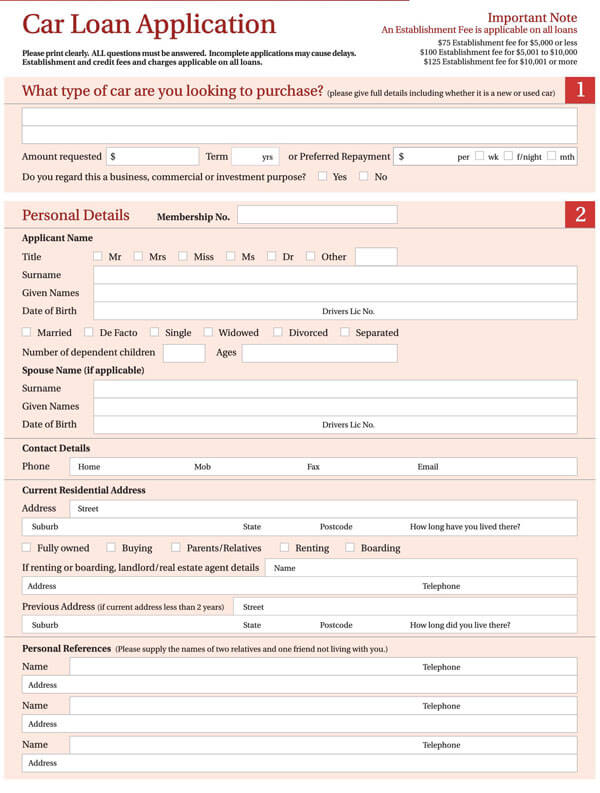
Collateral is defined as something that helps secure a loan. Generally, based on the type of lending institution you pick, the lender will give you less than your pledged asset value. Lenders every so often quote an acceptable loan to value ratio, meaning that if you borrow against your house, for example, and it worth $400,000, you will be given a loan amounting to $380,000. Again, this depends on the bank.
The prepayment penalty is a fee that some lenders charge if you pay off all or part of your loan before the loan’s maturity date. These do not usually apply if you pay extra principal on your loaned amount in small amounts at a time. However, it is good that you counter check with your lender.
Every lender follows a different criterion to approve a business or personal loan. The application process depends on several factors; therefore, the time taken to receive funding in your account may take anywhere from a few minutes to several days. This depends on the type of institution you choose and the type of loan you are asking for.
Acquiring a loan is sometimes a necessity in one’s business or personal life. Nonetheless, it is not always easy to get a loan as lenders are wary of granting loans due to loan repayment defaults and fraudulent borrowers. This article has provided you with great insight on loan application letters, the loan application process, essential tips for writing a winning loan application letter, and the dos and don’ts of writing a convincing loan request letter. If you keep these things in mind every time you are thinking of applying for a loan, you are sure to get the funds you need to ensure the smooth running of your business and sort any personal emergency that may come your way.
Related Documents
Original text

A bank loan request is a letter that accompanies your bank loan application package. Similar to a cover letter accompanying a resume, the bank loan request should highlight the key points of your business and sum up your request.

How to Write a Bank Loan Request Letter
Lenders are busy people, so keep your bank loan request brief. It should be a one- or two-page document that the banker can scan quickly to get the gist of your request. The full details about your business and your loan request will be included in the loan application, financial projections, and business plan you submit.
- Start your bank loan request by briefly explaining what your business does. You can use the executive summary from your business plan as a reference point in writing this part of the letter.
- Include essential business information. This includes your name, the business’s legal name, your legal form of business, business address, the year the business was founded, annual sales, number of employees, key customers, and any other indicators of success.
- Specify how much money you would like to borrow and what type of loan you are seeking. For example, do you want a working capital loan to purchase inventory or a loan to buy a building for your business?
- Explain how you will use the loan proceeds to attain specific business goals . Detail the measurable results you expect the loan to have on your business, such as increasing sales by 10% annually or doubling production capacity in six months.
- List any assets and debts. State the assets you have that could be used as collateral for the loan, as well as any outstanding business debts and when they will be paid off.
- End by listing the documents you’re including with the bank loan request and stating that you will contact the banker soon to follow up on your request.
A professional, compelling bank loan request can spur interest in your loan application and increase your chances of approval.
Do you need help fine-tuning your bank loan request? Contact a SCORE mentor for free advice and assistance.
Access to Capital 101- Funding Options to Start and Grow Your Business Attend this insightful webinar for a discussion of the different options available to help you get the funding you need.
Online Small Business Loan Worksheet There are more financing options for small businesses available than ever before. Use this worksheet to determine if an online lender right for your business.
Copyright © 2024 SCORE Association, SCORE.org
Funded, in part, through a Cooperative Agreement with the U.S. Small Business Administration. All opinions, and/or recommendations expressed herein are those of the author(s) and do not necessarily reflect the views of the SBA.
How to Write a Business Application Letter: A Comprehensive Guide for Success
Crafting a business application letter can feel like an intimidating task, but it doesn’t have to be. It’s all about presenting your qualifications in the best possible light and capturing the reader’s attention right from the start. Your business application letter is your initial introduction to a potential employer or partner, and it serves as a crucial first impression.
You’re not just writing a letter; you’re selling yourself, your skills, and your enthusiasm for the position or partnership at hand. That’s why each word you choose should reinforce the idea that YOU are indeed THE BEST candidate for this opportunity.
So how do you write a compelling business application letter? The key lies in understanding what your audience needs to see, organizing your thoughts clearly and concisely, then artfully weaving those elements together into an engaging narrative that commands attention. Let’s delve into some practical strategies to help guide you through this process.
Understanding the Basics of a Business Application Letter
Diving into the world of business, you’ll often find yourself needing to write a business application letter. Whether you’re applying for a job, pitching your services, or seeking funding for your startup, knowing how to craft an effective letter can give you an edge.
First off, it’s essential to grasp what a business application letter is. In essence, it’s a formal document used by individuals or corporations to conduct professional correspondence. You might use one to showcase your qualifications and express interest in an opportunity.
Now let’s break down its key components:
- Header : This section contains your contact information (like name and email) as well as the recipient’s details. Accuracy is paramount here; double-check everything!
- Salutation : It addresses the recipient directly. If possible, always try to find out their name.
- Body : Here lies the heart of your message. Keep it concise yet compelling enough to grab attention.
- Closing and signature : Wrap up your thoughts neatly and sign off gracefully.
Remember that every word counts in such letters! Make sure each sentence adds value and moves towards achieving your goal: persuading the reader in some way.
Here’s a nifty table summarizing these points:
Lastly, consider tone – maintaining professionalism doesn’t mean losing all personality! Inject some warmth where appropriate; after all, there’s a human on both ends of this communication!
With these basic guidelines under your belt, you’re ready to start crafting impactful business application letters!
Key Elements to Include in Your Letter
When you’re writing a business application letter, there are some key elements you need to include. By incorporating these components, you’ll boost your chances of making a great impression and getting that all-important call back.
First off, your contact information is crucial. It’s essential for the recipient to have your details at their fingertips if they want to get in touch with you. This includes:
- Phone number
- Email address
Next up is the date . Including the date at the top of your letter makes it clear when it was written – an important detail if there’s any delay between writing and receiving.
Then comes the recipient’s information . You should know who you’re addressing – not just the company or organization but also the individual person if possible.
The next must-have element is a salutation like ‘Dear Mr./Ms./Dr.’ followed by their last name. If you don’t know who specifically will be reading your letter, a simple “To Whom It May Concern” will do.
Now we’re getting into the meat of it – the body of your letter , which can be divided into three parts:
- Introduction: Explain why you’re writing.
- Main content: Describe what makes YOU the right fit for this opportunity.
- Conclusion: Summarize and express hope for further communication.
Lastly, don’t forget about closing remarks , such as ‘Sincerely’ or ‘Best regards’, and then leave space for your signature before typing out your full name underneath.
While this might seem like a lot to remember, it’s really quite straightforward once you’ve got the hang of it! And remember – while these elements are all important inclusions in any business application letter, what REALLY sets yours apart from others will come down to how effectively YOU present yourself within them!
Setting the Right Tone for Business Correspondence
When it comes to writing a business application letter, the tone you set is just as important as the content. Your tone represents your professional persona and can significantly influence how your message is received.
First impressions matter , especially in a business setting. You don’t get to meet face-to-face in written communication, so it’s crucial that your words speak volumes about your professionalism and competence. This starts with the greeting – ensure it’s formal and respectful. Avoid slang or overly casual language.
Remember that brevity is key in business correspondence. Your application should be concise yet comprehensive – striking a balance between providing enough information and keeping things brief will show respect for the recipient’s time.
Your choice of words also plays an important role in setting the right tone. Aim for clear, straightforward language that conveys your intent without ambiguity. Utilize industry jargon sparingly – while it can demonstrate your knowledge, overuse may come across as pretentious or confusing.
Here are some more tips:
- Maintain politeness throughout.
- Be confident but avoid sounding arrogant.
- Use active voice where possible.
- Keep sentences short and paragraphs well-organized.
- Don’t forget to proofread – typos or grammar errors can undermine even the most professionally crafted messages!
Lastly, remember that different situations call for different tones – what works for a job application might not suit a complaint letter or resignation note. Always consider context when shaping your tone.
With these strategies in mind, you’re now equipped to write business correspondence that not only gets noticed but also makes a great impression!
Crafting an Effective Opening Paragraph
Crafting a compelling opening paragraph for your business application letter is crucial. It’s this first impression that can make or break your chances of getting noticed in the sea of applicants. Remember, you’re not just introducing yourself; you’re marketing your skills and qualifications.
Don’t rush into listing out all your credentials right off the bat. Instead, start with a powerful hook that piques the reader’s interest. Maybe it’s a noteworthy achievement relevant to the position, or perhaps it’s an innovative idea on how you plan to contribute to their organization.
You’ve got their attention? Good! Now, it’s time to establish why you’re writing. Be clear about the role you’re applying for and where you learned about the opportunity. But remember – keep it concise yet informative.
Here are some key points to consider while drafting:
- The salutation: Addressing the recipient by name shows initiative and respect.
- A strong introduction: Start with something compelling – an accomplishment, a unique skill set, or personal connection to their work.
- Clear intent: Explicitly state what job you’re applying for.
- Connection with company: Drop hints demonstrating familiarity with their work – aligning yourself with their mission and values can be quite effective.
Remember not to overdo details in this section; there will be plenty of time later in the letter for specifics about your qualifications and past experiences.
As always, proofread rigorously for any errors – grammatical or factual. After all, accuracy is paramount in professional communication!
By following these guidelines, you’ll craft an opening paragraph that’s engaging and sets a solid foundation for showcasing why you’re the best candidate for the job!
Highlighting Your Skills and Experiences
When it’s time to write your business application letter, you’ll want to make sure your skills and experiences take center stage. So, how do you go about this? It’s easier than you might think.
First off, identify the key skills the company is seeking. You’ll often find these listed in the job description or advertisement. Once you’ve got a clear idea of what they’re looking for, it’s time to match those requirements with your own abilities.
Don’t be shy about showcasing your talents! If you’ve got a knack for project management or a proven track record in sales, make sure that comes across loud and clear. Use concrete examples from previous roles to highlight not only what you did but also how well you did it.
Let’s say sales was one of your strong points in a past role:
- Increased annual sales by 20% through effective client relationship management.
- Led a team that exceeded quarterly targets by 15% consistently over two years.
- Implemented new strategies which resulted in an additional $100k revenue per quarter.
Remember, each bullet point should be concise and impactful. Avoid fluff – stick to quantifiable achievements when possible.
But what if you’re fresh out of college with little work experience? Don’t worry, we’ve all been there! Highlight relevant coursework or academic projects that demonstrate applicable skills. Did you ace a marketing class? Or perhaps led a successful fundraising drive for a student organization? These experiences matter too!
The same rules apply – keep things succinct and focus on results:
- Achieved top marks in Advanced Business Strategy course.
- Raised $5k for local charity as Student Union Treasurer.
Finally, don’t forget transferable skills – abilities like problem-solving, communication, teamwork – essentially anything that could potentially benefit any employer regardless of industry.
In short, remember: identify key skills required; match them with your own; provide concrete examples , even from academia; highlight transferable skills . By following these steps diligently, your skills and experiences will shine brightly on paper!
Making Your Case: Tailoring the Content to the Job Description
Crafting a compelling application letter isn’t about ticking off all the boxes on your resume. It’s about making your skills, experiences, and personality shine in a way that resonates with the job you’re applying for. Here’s how to tailor your content effectively.
Firstly, understand that the job description is your friend . It’s not just a list of duties or qualifications—it’s a blueprint for what the company values in an employee. So take time to dissect it thoroughly.
- Look for recurring themes or phrases.
- Identify key skills or competencies mentioned.
- Highlight any specific examples of success outlined.
Once you’ve analyzed these points, align them with your own experiences and strengths. For example:
Next, let’s translate this analysis into compelling content within your business application letter. Don’t just state facts—tell stories that demonstrate how you meet each requirement.
For instance, instead of saying “I have strong communication skills”, narrate an instance where those skills led to tangible results: “In my previous role as project manager at XYZ Corp., I utilized effective communication strategies during team meetings which increased productivity by 20%.”
Another vital tip is using keywords directly from the job description – but in moderation! Overstuffing will make your letter sound robotic and insincere; balance is key here.
Remember, tailoring doesn’t mean faking it till you make it! If there are requirements that don’t match up perfectly with your experience, be honest but optimistic about learning new things.
Finally, proofread and revise until every sentence underscores why you’re the right fit for this particular job . Crafting such an application letter takes effort—but when done correctly, it can significantly boost your chances of landing that dream position!
In conclusion (but without starting with “In conclusion”), successful business application letters require thoughtful tailoring based on thorough understanding of the job description. With attention to detail and authenticity shining through every word written, landing your dream job may be closer than you think.
The Importance of a Strong Closing Statement
Your closing statement in a business application letter is your final opportunity to leave a lasting impression. It’s crucial for several reasons. First, it summarizes the key points you’ve made throughout your letter and reiterates why you’re the ideal candidate for this position. Second, it provides an opportunity for you to show enthusiasm and eagerness about the potential of joining the team.
A strong closing statement isn’t just about summarizing your qualifications or expressing interest though; it’s also a chance for you to convey how serious and committed you are. This can be done by initiating further action – like suggesting a follow-up meeting or indicating that you’ll reach out within a certain timeframe.
Here are some components that make up an impactful closing statement:
- Summary of key points : Recapitulate on what makes you stand out as an ideal candidate.
- Expression of interest : Show enthusiasm towards the job role and company.
- Call-to-action : Indicate next steps (e.g., looking forward to an interview, will follow up in one week).
If done correctly, these elements together can create a compelling conclusion that leaves no doubt in the reader’s mind about your suitability for the role.
Remember, recruiters scan through hundreds of applications daily. A concise but powerful ending can set yours apart from others by leaving a memorable impression in their minds. So don’t underestimate its impact – spend time crafting it with care because every word counts!
In summary, when writing your business application letter, pay as much attention to crafting a strong closing statement as you would any other part – after all, it could be what clinches the deal for getting called into that interview room!
Proofreading and Editing: Ensuring Professionalism
Proofreading and editing are crucial components of writing a business application letter. They’re not just optional extras – they’re essential to ensure your professionalism shines through.
When you’ve completed your draft, don’t rush to hit the send button. Instead, take some time to proofread it thoroughly. You’ll want to check for any spelling or grammar errors that might have slipped in unnoticed. These can be detrimental as they can project a lack of attention to detail.
It’s also important to review the structure and flow of your letter. Make sure all points are logically arranged and easily understandable. Remember, conciseness is key in business communication – long-winded sentences can lose the reader’s interest.
Note: Don’t rely solely on spellcheckers. While these tools are handy, they might miss context-specific mistakes or homonyms (words that sound alike but have different meanings).
Editing goes beyond mere error-checking though. It involves refining your message for maximum impact:
- Check if you’ve addressed all requirements mentioned in the job description.
- See whether each paragraph contributes effectively towards building your case.
- Evaluate if there’s repetition; if so, eliminate it.
- Ensure you’ve maintained a professional tone throughout.
Here’s a quick checklist for proofreading and editing:
Remember, it’s always beneficial to get another pair of eyes on your work before finalizing it – fresh perspective often catches overlooked issues.
In sum, proofreading and editing aren’t just about finding typos; they’re integral steps towards creating an effective business application letter that leaves an impression. So don’t skimp on them; instead, use them as powerful tools to make sure every word counts!
Sample Business Application Letters for Inspiration
Let’s dive into some examples of business application letters that can inspire you. These samples will provide a practical understanding of how to structure your own letter and what key points need to be included.
The first example is an application letter for a marketing position . Here, it’s crucial to highlight your relevant skills, previous marketing experiences, and achievements in the field:
Another sample caters to those seeking a role in project management . Notice how it emphasizes organization skills, leadership qualities, and past projects:
For those looking towards finance roles , observe how this next example showcases knowledge about financial models and data analysis:
Remember these general tips when crafting your own application letter:
- Tailor it specifically towards the job requirements
- Highlight relevant skills and experiences
- Showcase achievements related to the applied position
- Keep it concise yet comprehensive
- Be professional throughout
These samples should serve as excellent starting points when creating your own compelling business application letters!
Conclusion: Mastering Your Business Application Letter Writing
You’ve made it! You’re now equipped with the knowledge and tools to craft a compelling business application letter. Remember, success in writing these letters isn’t about using big words or complex sentences. It’s more nuanced than that.
Your goal is to convey your message succinctly and clearly. Don’t forget to:
- Start strong with a compelling introduction.
- Highlight your relevant skills and experiences.
- Showcase how you can add value to the organization.
The power of brevity should never be underestimated. Keep your letter concise – generally no more than one page in length. Respect your reader’s time while ensuring they get a full picture of what you bring to the table.
Proofread, proofread, then proofread some more. Nothing undermines your professionalism like typos or grammatical errors.
Lastly, don’t underestimate the sign-off – it’s your final chance to make an impression. Leave them eager for further interaction by expressing anticipation for their positive response.
Writing a business application letter may seem daunting at first glance but remember, practice makes perfect. The more you write, the better you’ll get at honing this vital skill.
So go ahead – put pen to paper (or fingers to keyboard) and start crafting that killer business application letter today! With persistence and dedication, you’ll soon master this integral aspect of professional communication.
All Formats
22+ Sample Loan Application Letters – PDF, DOC
There are times when we need financial aid to push through with our education, business ideas, or other personal projects or goals which require a huge amount of money for its realization. It is for this reason that lending companies have been existing ever since the days of old. Today, the primary step to being taken by someone who wants to borrow money from another individual or institution is to write a loan application letter .
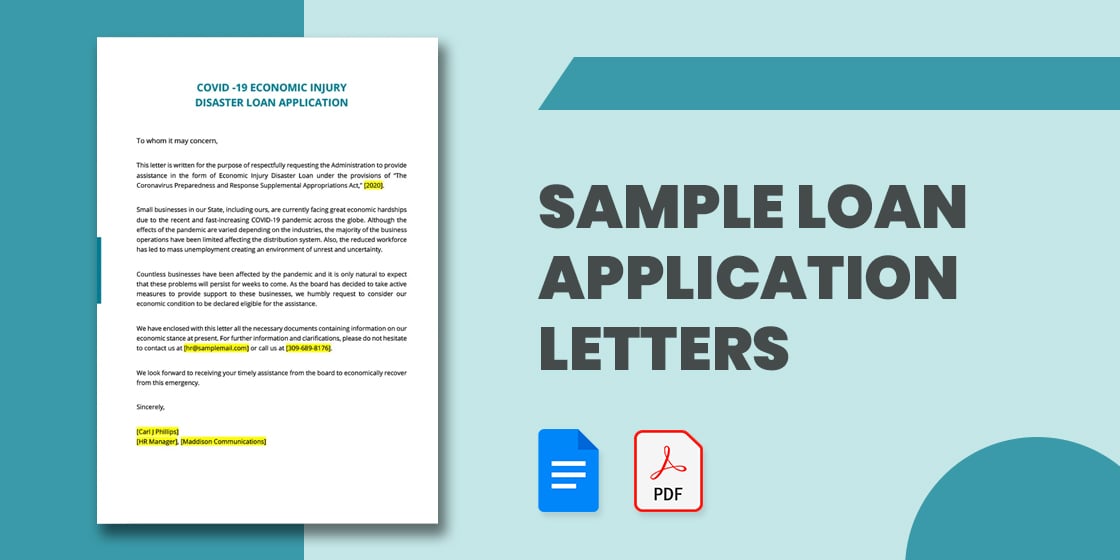
Loan Application Letter
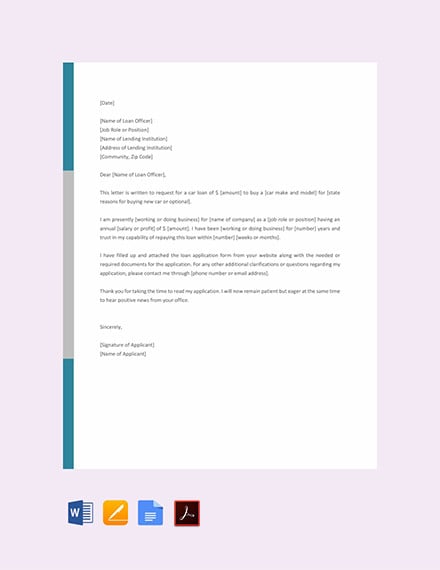
- Google Docs
- Apple Pages
Application for Loan Sample PDF
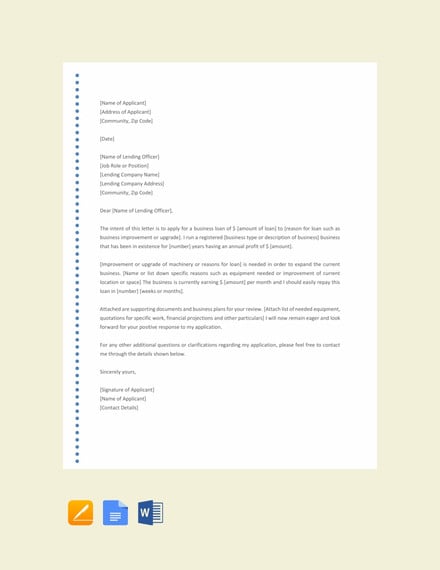
Simple Loan Application Letter
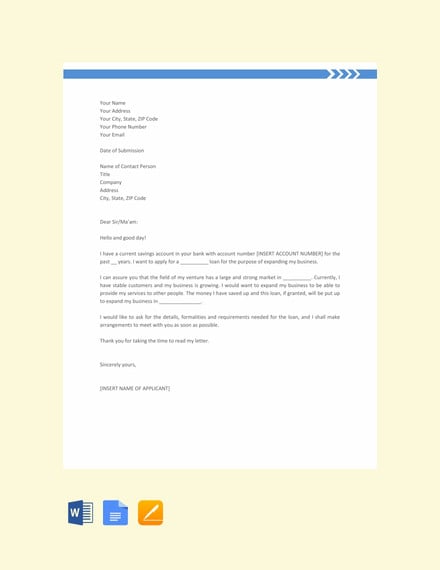
Application for Loan
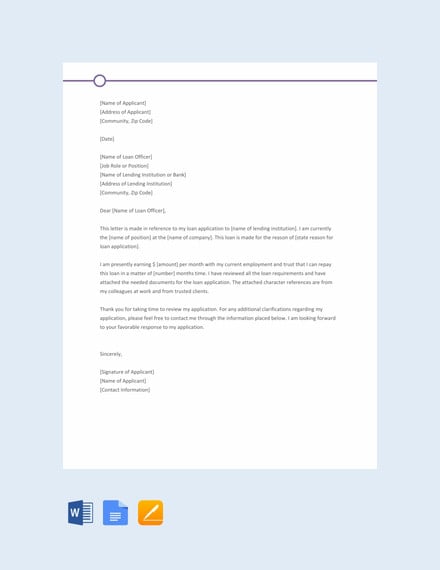
Loan Letter Sample
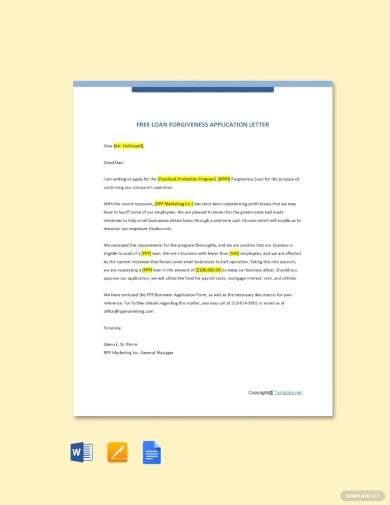
Loan Request Letter
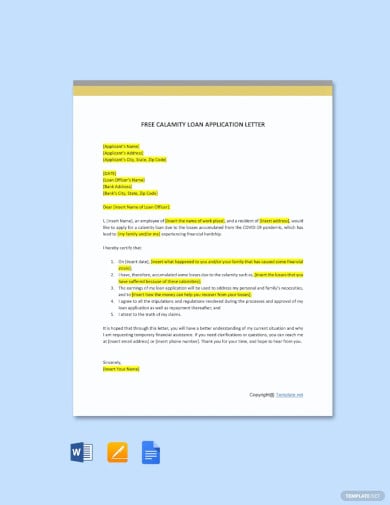
Letter for Loan Request
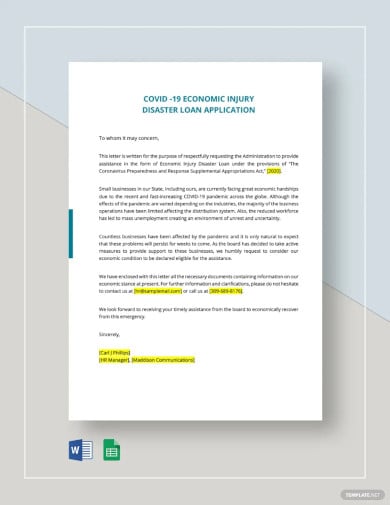
Formal Loan Purpose Application Letter to Senior Manager
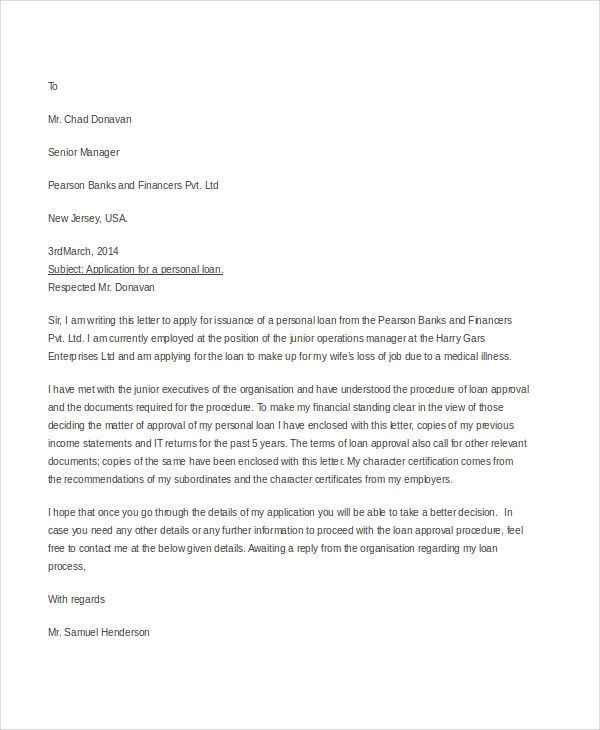
Formal Event Management Small Business Letter

Sample Vehicle Application Letter Example
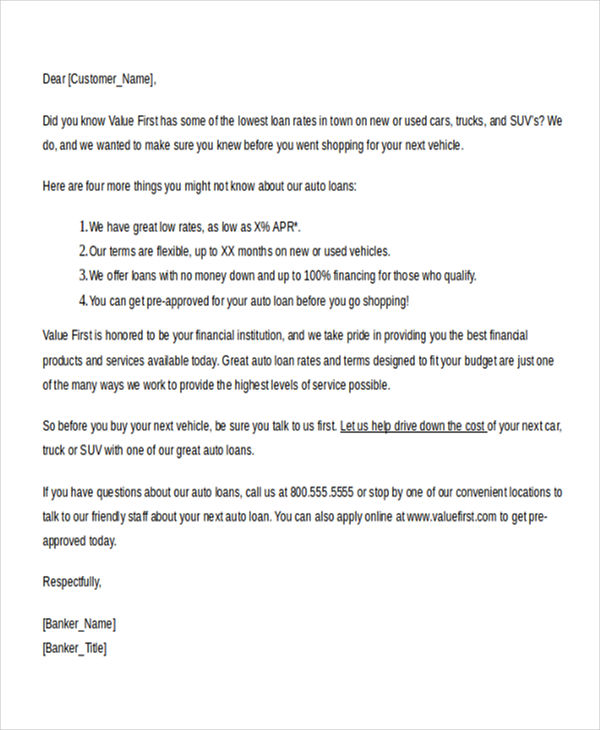
Agricultural Office Vehicle Application Letter Template
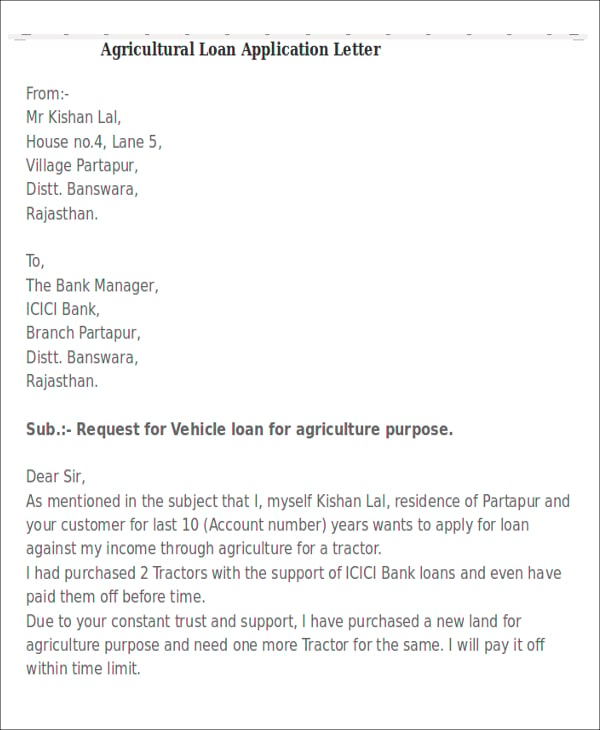
Sample Foreclosure Disbursement Apllication Form Letter
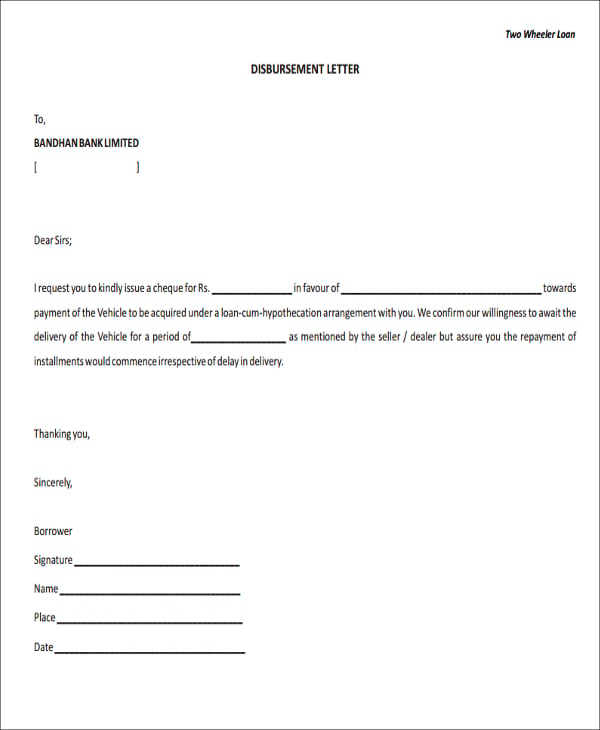
Example Work Travel Agency Letter
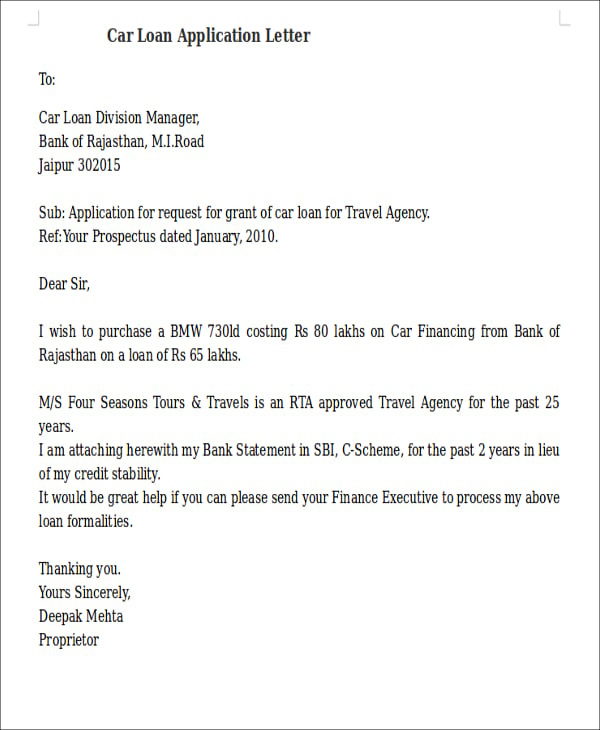
Application Letter to Canadian Bank for Loan
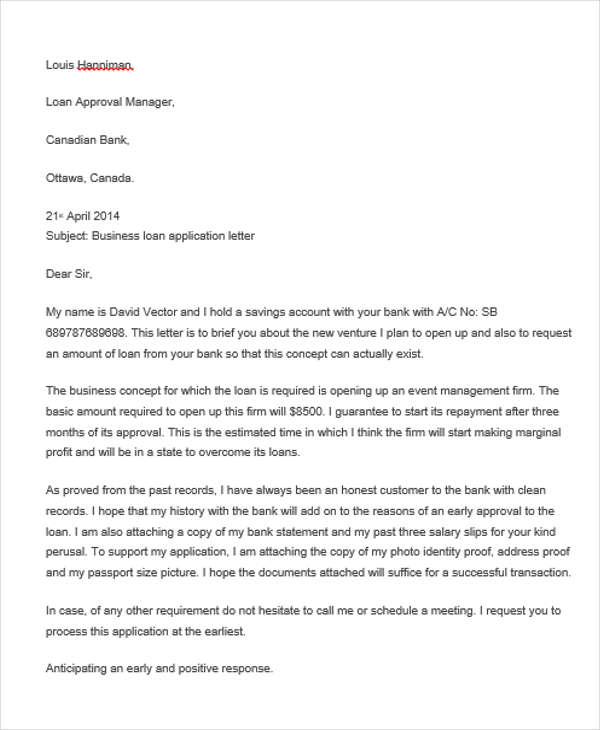
Sales Department Employee Application Letter Example
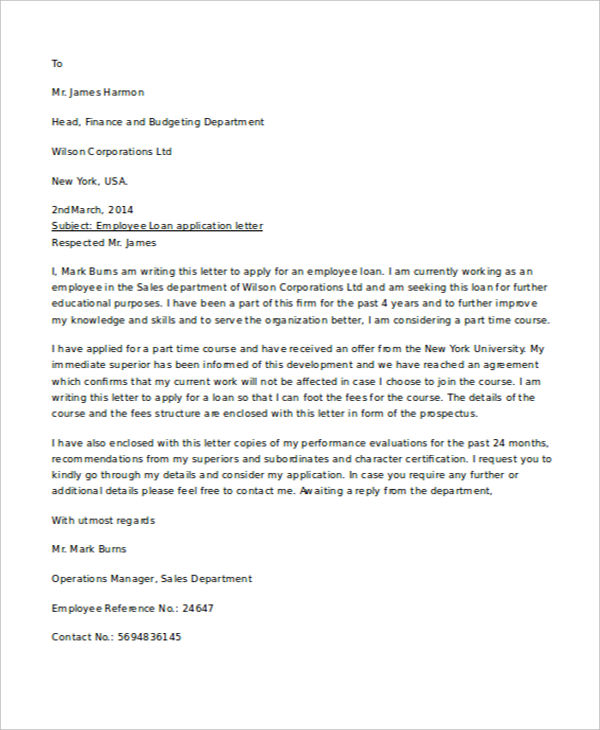
The Loan Application Process
- Before the loan contract , the borrower would send a loan application cover letter to the prospective lender to express his or her intent to ask for a loan.
- Afterward, when the lender has decided to consider the application for a loan made by the borrower, the borrower, and the lender would convene to negotiate the terms of the loan.
- The payment method, whether personal, through a check, online banking, etc.
- The number of times the payment is going to be made. There are various options. For example, the loan can be paid at one time, or it can be done in yearly or monthly installments.
- The amount of interest to be added on top of the loaned amount. The interest is the amount of money that is charged by the lender to the borrower on top of the amount which he/she has loaned. You may also see job reference letters .
- The assets (land, buildings, vehicles, or other properties) of the borrower would serve as collateral damage in case the borrower fails to make his/her payment on the time it is due.
Basic Senior Typist Home Loan Application Letter Template
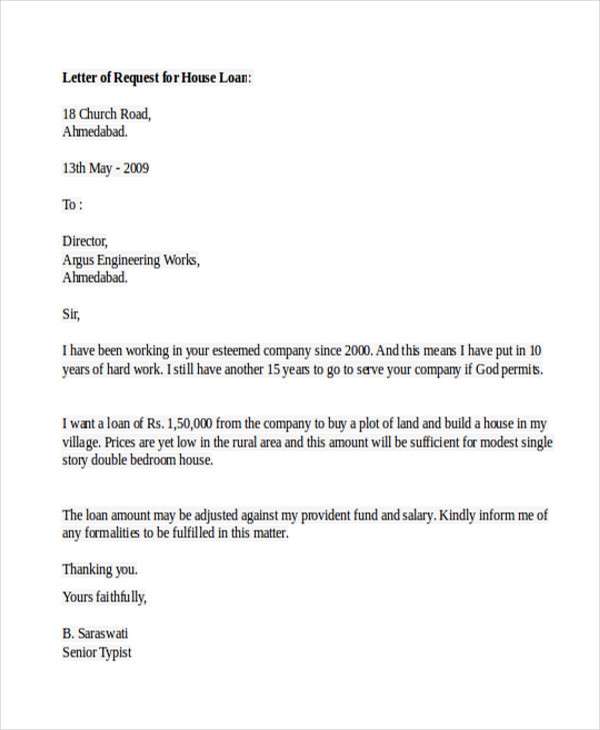
Mortgage Loan Application Letter with Boss Recommendation
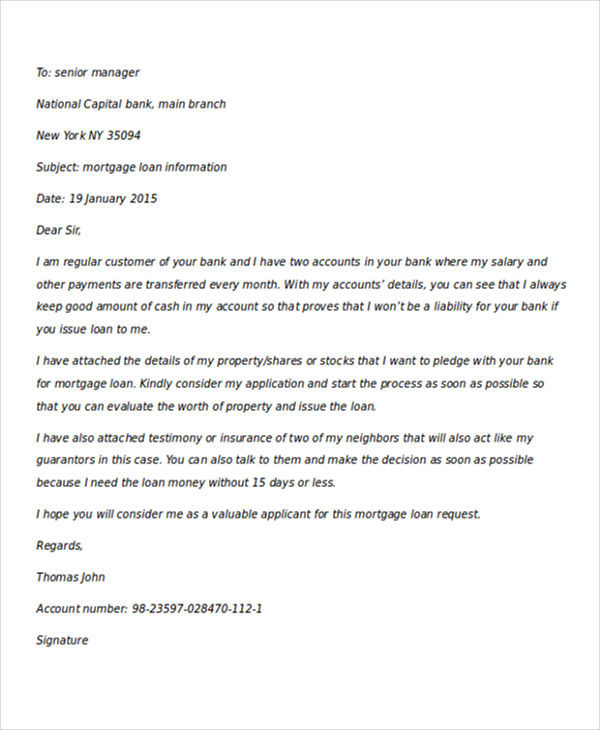
Professional Medical Loan Facility for Cancer Treatment
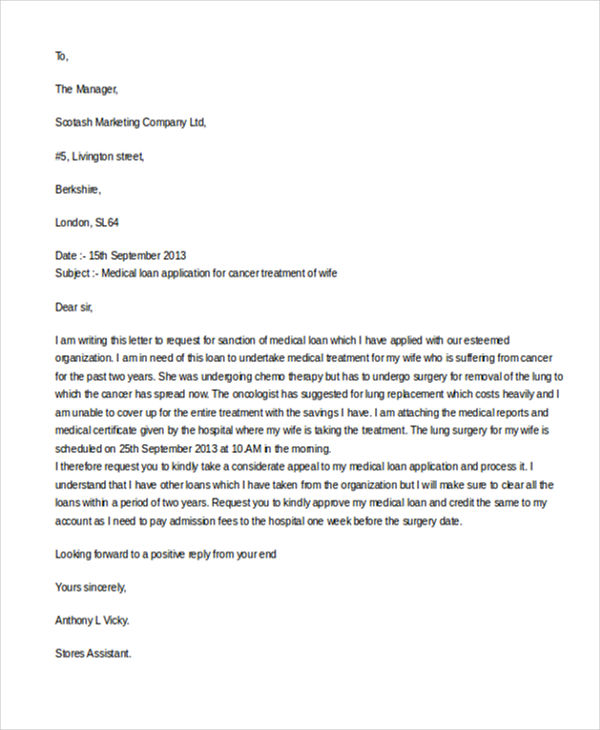
Professional Education Application Letter Template

Request Urgent / Emergency Loan Letter for Borrowing Money
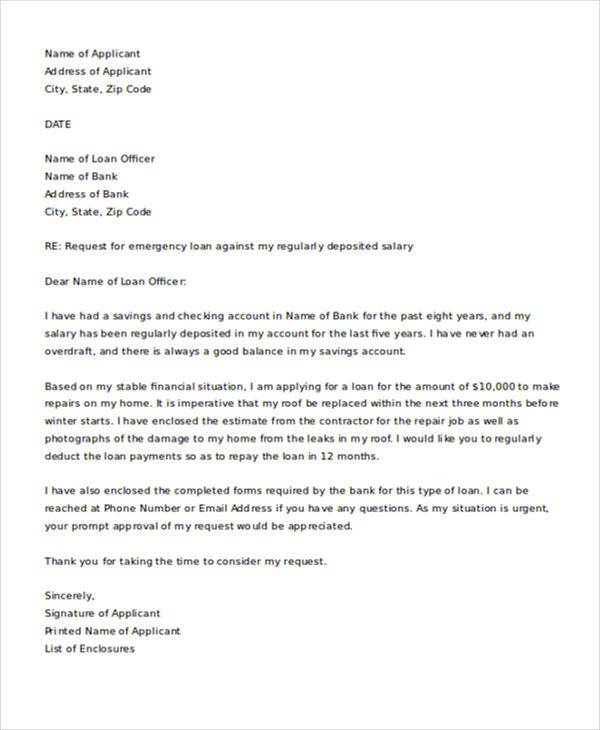
Free Commercial Vehicle Application Letter Template
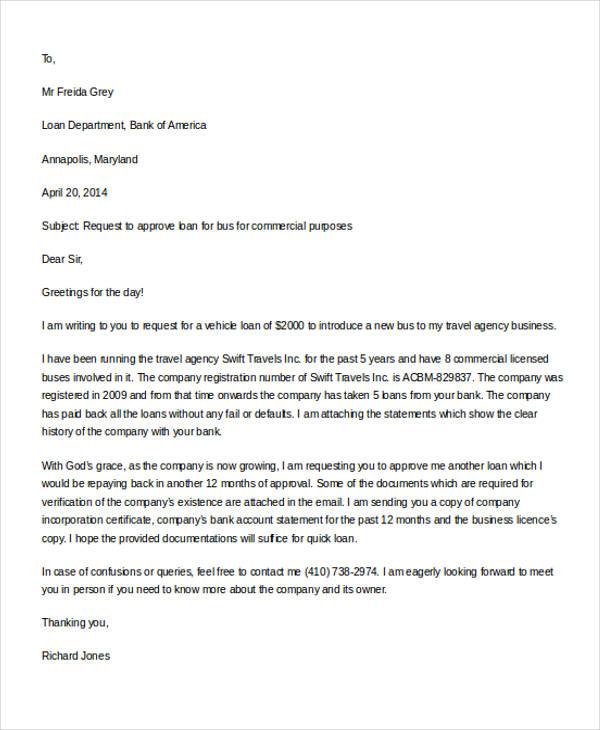
Loan Application Letter for Wedding/Marriage Template

Sample Staff Loan Request Application Letter for Covid-19
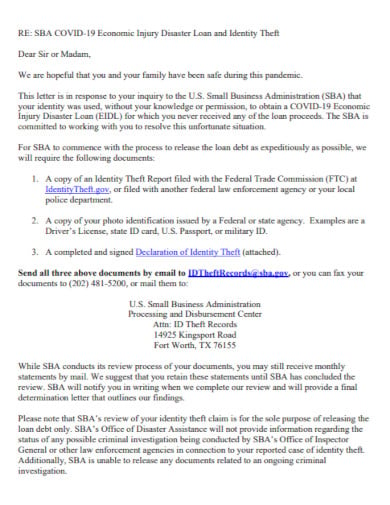
Things To Remember in Writing a Loan Application Letter
- Observe the proper rules for writing formal letters.
- State your intent to borrow a specific amount of money.
- Explain in detail the reason for borrowing money. You must be offering a clear, honest, and transparent explanation as to how you intend to utilize the money you intend to borrow. You may also see free application rejection letters .
- Enumerate your assets and liabilities.
- State the time, date, manner, and method which you prefer to make your payment.
More in Letters
Loan application letter template, loan requisition letter, sample loan application letter template, simple loan application letter template, loan application letter to employer template, personal loan application letter template, loan application letter for school fees template, loan application letter to bank manager template, loan application letter for house rent template, loan application letter from employee template.
- FREE 26+ Covid-19 Letter Templates in PDF | MS Word | Google Docs
- Thank You Letter for Appreciation – 19+ Free Word, Excel, PDF Format Download!
- 69+ Resignation Letter Templates – Word, PDF, IPages
- 12+ Letter of Introduction Templates – PDF, DOC
- 14+ Nurse Resignation Letter Templates – Word, PDF
- 16+ Sample Adoption Reference Letter Templates
- 10+ Sample Work Reference Letters
- 28+ Invitation Letter Templates
- 19+ Rental Termination Letter Templates – Free Sample, Example Format Download!
- 23+ Retirement Letter Templates – Word, PDF
- 12+ Thank You Letters for Your Service – PDF, DOC
- 12+ Job Appointment Letter Templates – Google DOC, PDF, Apple Pages
- 21+ Professional Resignation Letter Templates – PDF, DOC
- 14+ Training Acknowledgement Letter Templates
- 49+ Job Application Form Templates
File Formats
Word templates, google docs templates, excel templates, powerpoint templates, google sheets templates, google slides templates, pdf templates, publisher templates, psd templates, indesign templates, illustrator templates, pages templates, keynote templates, numbers templates, outlook templates.

How to Write a Loan Application Letter in Nigeria
Do you find it difficult to write a loan application letter or you are clueless about how to go about the process?
No need to fret, you have come to the right page for a solution.
It is not surprising that a lot of Nigerians apply for loans in various financial organisations ranging from commercial banks, and microfinance banks, and that online loan apps are on the increase in Nigeria.
Due to the current economic hardship coupled with debts incurred by some Nigerians, to settle their debts, they simply look forward to applying for a loan as a solution to their problems.
Nigerians apply for loans for different reasons and purposes. Some for their businesses, education, to pay off debt while some apply for loans to “japa”.
If you’re looking to apply for a loan here in Nigeria, in simple steps, I’ll guide and put you through how to write a loan application letter in Nigeria.
Table of Contents
Applying For a Loan in Nigeria
Firstly, you need to have a plan, ask yourself the question “what do I need this money for?”
Will the business you’re planning to venture into be productive enough to pay back the loan you’re applying for in the bank?
If you don’t have a plan, at the end of the day, when you write the application for a loan, you often find it difficult to pay back the loan.
This is why some of these loan sharks make public the loan defaulters personal details on social media platforms creating public embarrassment to the defaulters and the people close to them.
Steps in Applying for a Loan
The major thing you should look out for as you’re about to apply for a loan in Nigeria is the financial institution you want to go for.
Put in mind their interest rates, the loan duration (how long will it take for you to pay off?).
Read properly the T&Cs, and read it line by line before you append your signature.
Lots of Nigerians applying for loans make the mistake of not going through the terms and conditions thoroughly, you definitely don’t want to make this mistake to avoid “had I known?”
Don’t be too eager, I repeat, don’t be too eager.
Just recently someone told me something I want you to pick from, she said “one of the policies in giving loans is not to give a loan to a customer that is too eager, the one who never lets you rest”.
Read also: How to get loans without a salary account or collateral.
How to Write a Loan Application Letter
Writing a loan application letter in Nigeria is quite simple as you can refer to the letters you wrote while in school.
Your loan application letter should be well detailed and concise, not verbose.
There are two things to consider here, are you applying for personal use or for your company?
If it is a personal loan, it is simple, all you have to do is to walk into any bank of your choice to make some findings.
Make sure you get a clean sheet of paper (A4 Paper), your identity card (work id is included), a letter of introduction from your working place if you’re an employee of an organisation.
I’ll list out in bullet points what should be included in your loan application letter so you won’t make any mistakes or leave any information out of your loan application letter.
NOTE: You’re writing a formal letter, not an informal letter.
- The bank’s address (include the branch manager if you’re addressing the letter to him/her. This should be on the left side of your A4 paper.
- Your address should be on the right side of your letter.
- Under the address to the bank, “Dear Ma/Sir” should be written.
- Heading: You should provide heading to your loan application letter. See more details in the samples below.
- Body of your letter: You should explain in detail the reason and the duration.
Read also: Top banks in Nigeria for entrepreneurs.
Samples of a Loan Application Letter
Below are samples of loan application letters for an individual/personal use:
To the Branch Manager,
United Bank for Africa,
Lebanon Dugbe,
23rd April 2009.
40, Boladuro Street,
Challenge Ibadan,
Dear Ma/Sir,
LOAN REQUEST
I (your name), with the account number (×××××××××) wish to request for a loan in your business office.
I look forward to hearing from you soon.
Thanks in advance.
Yours faithfully,
(Signature)
(Phone number).
Applying for a loan in the name of your company? Ensure you have a great turnover with the bank to get a good loan.
The letter for loan application should be on your company’s letterhead. You can’t apply for a loan in Nigeria as a company on a plain sheet of paper.
XYZ CONSULTING FIRM LTD.
+234***********, 40 Boladuro Street Challenge Ibadan. Oyo State.
To the Branch Manager,
No 40 Boladuro Street,
Dear Sir/Ma,
Our company (name), with the account number (×××××××××) wishes to request for a loan in your business office to get some equipment for our business.
Sponsor your business on Insight.ng for a wider reach of your target audience.
Applying For a Loan on Your Mobile Phone
Do you know you can pick up your phone and apply for that loan you’ve been searching for?
Simply visit the Play Store/Apple store app, there are lots of applications offering loan services.
From Okash to New Credit, Fairmoney, 9ja Cash, Soko Loan and a host of others.
It is not surprising that some Nigerians prefer to apply for a loan using these mobile applications than walking into the bank.
Everyone wants comfort and a very easy experience.
Once you download the application of your choice, you click on the register button (all your information would be recorded together with your bank verification number).
While some Nigerians don’t like to apply for a loan from these Loan apps, due to the embarrassment/disgrace they put people through if they fail to make payment after the payback day, some apply for the loan and pay back in due time.
Read also: Top 10 best loan apps in Nigeria.
Conclusion
I hope you’ve learnt a thing or two from this article on how to write a loan application letter in Nigeria.
Whenever you’re in a fix or there’s something really urgent you need money to settle, you can simply visit any bank branch to make enquiries on the type of loan product they have to offer, or make use of online apps.
If you found this useful, subscribe to our newsletter for more insightful posts.
About Author
Latest entries

Angela Ajani
Give her books and you've made her day. Ajani Angela is a graduate of History and International Studies from Bowen University, currently pursuing her Masters Degree in Peace and Conflict Studies at the University of Ibadan. Angela loves to read and meet new people. Her interests are not limited to just education; she also loves to offer advice to people going through a lot. Angela loves to hear from readers. You can email her at [email protected] .
Expertnaire Tutorial: How to Start Making Millions in Expertnaire in Nigeria
How to write news stories: path to becoming a successful journalist in nigeria, related posts, effective strategies for managing cash flow in a..., the role of board of directors in a..., a guide to understanding intellectual property rights for..., the impact of government policies on nigerian businesses, top 17 prosperous business opportunities to consider in..., robotic process automation (rpa) in nigerian businesses, leave a comment.
Save my name, email, and website in this browser for the next time I comment.
- Auto Insurance Best Car Insurance Cheapest Car Insurance Compare Car Insurance Quotes Best Car Insurance For Young Drivers Best Auto & Home Bundles Cheapest Cars To Insure
- Home Insurance Best Home Insurance Best Renters Insurance Cheapest Homeowners Insurance Types Of Homeowners Insurance
- Life Insurance Best Life Insurance Best Term Life Insurance Best Senior Life Insurance Best Whole Life Insurance Best No Exam Life Insurance
- Pet Insurance Best Pet Insurance Cheap Pet Insurance Pet Insurance Costs Compare Pet Insurance Quotes
- Travel Insurance Best Travel Insurance Cancel For Any Reason Travel Insurance Best Cruise Travel Insurance Best Senior Travel Insurance
- Health Insurance Best Health Insurance Plans Best Affordable Health Insurance Best Dental Insurance Best Vision Insurance Best Disability Insurance
- Credit Cards Best Credit Cards 2024 Best Balance Transfer Credit Cards Best Rewards Credit Cards Best Cash Back Credit Cards Best Travel Rewards Credit Cards Best 0% APR Credit Cards Best Business Credit Cards Best Credit Cards for Startups Best Credit Cards For Bad Credit Best Cards for Students without Credit
- Credit Card Reviews Chase Sapphire Preferred Wells Fargo Active Cash® Chase Sapphire Reserve Citi Double Cash Citi Diamond Preferred Chase Ink Business Unlimited American Express Blue Business Plus
- Credit Card by Issuer Best Chase Credit Cards Best American Express Credit Cards Best Bank of America Credit Cards Best Visa Credit Cards
- Credit Score Best Credit Monitoring Services Best Identity Theft Protection
- CDs Best CD Rates Best No Penalty CDs Best Jumbo CD Rates Best 3 Month CD Rates Best 6 Month CD Rates Best 9 Month CD Rates Best 1 Year CD Rates Best 2 Year CD Rates Best 5 Year CD Rates
- Checking Best High-Yield Checking Accounts Best Checking Accounts Best No Fee Checking Accounts Best Teen Checking Accounts Best Student Checking Accounts Best Joint Checking Accounts Best Business Checking Accounts Best Free Checking Accounts
- Savings Best High-Yield Savings Accounts Best Free No-Fee Savings Accounts Simple Savings Calculator Monthly Budget Calculator: 50/30/20
- Mortgages Best Mortgage Lenders Best Online Mortgage Lenders Current Mortgage Rates Best HELOC Rates Best Mortgage Refinance Lenders Best Home Equity Loan Lenders Best VA Mortgage Lenders Mortgage Refinance Rates Mortgage Interest Rate Forecast
- Personal Loans Best Personal Loans Best Debt Consolidation Loans Best Emergency Loans Best Home Improvement Loans Best Bad Credit Loans Best Installment Loans For Bad Credit Best Personal Loans For Fair Credit Best Low Interest Personal Loans
- Student Loans Best Student Loans Best Student Loan Refinance Best Student Loans for Bad or No Credit Best Low-Interest Student Loans
- Business Loans Best Business Loans Best Business Lines of Credit Apply For A Business Loan Business Loan vs. Business Line Of Credit What Is An SBA Loan?
- Investing Best Online Brokers Top 10 Cryptocurrencies Best Low-Risk Investments Best Cheap Stocks To Buy Now Best S&P 500 Index Funds Best Stocks For Beginners How To Make Money From Investing In Stocks
- Retirement Best Gold IRAs Best Investments for a Roth IRA Best Bitcoin IRAs Protecting Your 401(k) In a Recession Types of IRAs Roth vs Traditional IRA How To Open A Roth IRA
- Business Formation Best LLC Services Best Registered Agent Services How To Start An LLC How To Start A Business
- Web Design & Hosting Best Website Builders Best E-commerce Platforms Best Domain Registrar
- HR & Payroll Best Payroll Software Best HR Software Best HRIS Systems Best Recruiting Software Best Applicant Tracking Systems
- Payment Processing Best Credit Card Processing Companies Best POS Systems Best Merchant Services Best Credit Card Readers How To Accept Credit Cards
- More Business Solutions Best VPNs Best VoIP Services Best Project Management Software Best CRM Software Best Accounting Software
- Manage Topics
- Investigations
- Visual Explainers
- Newsletters
- Abortion news
- Coronavirus
- Climate Change
- Vertical Storytelling
- Corrections Policy
- College Football
- High School Sports
- H.S. Sports Awards
- Sports Betting
- College Basketball (M)
- College Basketball (W)
- For The Win
- Sports Pulse
- Weekly Pulse
- Buy Tickets
- Sports Seriously
- Sports+ States
- Celebrities
- Entertainment This!
- Celebrity Deaths
- American Influencer Awards
- Women of the Century
- Problem Solved
- Personal Finance
- Small Business
- Consumer Recalls
- Video Games
- Product Reviews
- Destinations
- Airline News
- Experience America
- Today's Debate
- Suzette Hackney
- Policing the USA
- Meet the Editorial Board
- How to Submit Content
- Hidden Common Ground
- Race in America
Personal Loans
Best Personal Loans
Auto Insurance
Best Auto Insurance
Best High-Yields Savings Accounts
CREDIT CARDS
Best Credit Cards
Advertiser Disclosure
Blueprint is an independent, advertising-supported comparison service focused on helping readers make smarter decisions. We receive compensation from the companies that advertise on Blueprint which may impact how and where products appear on this site. The compensation we receive from advertisers does not influence the recommendations or advice our editorial team provides in our articles or otherwise impact any of the editorial content on Blueprint. Blueprint does not include all companies, products or offers that may be available to you within the market. A list of selected affiliate partners is available here .
Business Loans
Top long-term business loans: Best options for April 2024
Kiah Treece

Ashley Harrison
“Verified by an expert” means that this article has been thoroughly reviewed and evaluated for accuracy.
Published 11:00 a.m. UTC March 26, 2024
- path]:fill-[#49619B]" alt="Facebook" width="18" height="18" viewBox="0 0 18 18" fill="none" xmlns="http://www.w3.org/2000/svg">
- path]:fill-[#202020]" alt="Email" width="19" height="14" viewBox="0 0 19 14" fill="none" xmlns="http://www.w3.org/2000/svg">
Editorial Note: Blueprint may earn a commission from affiliate partner links featured here on our site. This commission does not influence our editors' opinions or evaluations. Please view our full advertiser disclosure policy .
Long-term business loans can help business owners secure capital for significant investments, such as expansion, equipment purchases or even refinancing existing debts. These loans generally offer repayment terms longer than two years, which can provide you with affordable monthly payments.
The best long-term business loans of 2024 not only come with these lengthy terms but also a variety of loan amounts, lenient credit score requirements and fast funding.
Best long-term business loans
- National Funding equipment financing : Best for fair credit.
- Kapitus business loan : Best for large loans.
- Rapid Finance business loan : Best for fast funding.
Best for fair credit
National funding equipment financing.

Loan amounts
Repayment terms, what you should know.
With an equipment financing loan from National Funding, you can borrow up to $150,000 and choose a repayment term from two to five years. If you’re approved, you can get your funds as soon as the next business day. Plus, if you opt to pay off your loan early, you can get a 6% discount on the remaining balance.
National Funding accepts credit scores as low as 600, which could make it ideal if you have fair credit (usually considered to be a score from 580 to 669). To qualify, your business must also have been in operation for at least six months, depending on your situation. Additionally, your business must generate at least $250,000 in annual revenue, and you’ll need to provide an equipment quote from a vendor with your application.
Note that National Funding charges an origination fee from 1% to 5%, which can impact your borrowing costs. It also doesn’t disclose its interest rates for equipment financing. To see what you might be eligible for, you’ll need to apply and discuss your options with one of the lender’s funding specialists.
Pros and cons
- Accepts fair credit scores.
- Discount available for early repayment.
- Fast funding.
- Doesn’t publish interest rates online.
- Charges an origination fee.
- Lower loan maximum compared to some lenders.
More details
- Loan amounts: Up to $150,000.
- Repayment terms: 2 to 5 years.
- Perks: Early repayment discount (6% of remaining balance).
- Fees: Origination fee (1% to 5%).
- Min. credit score: 600.
- Required time in operation: 6 months.
- Required annual revenue: $250,000.
- Time to fund: Within 1 to 3 business days after approval.
Best for large loans
Kapitus business loan.

Kapitus offers long-term business loans from $10,000 up to $5 million with terms as long as five years. This can make it a good choice if you’re looking to borrow a large amount.
To qualify, you’ll need a credit score of at least 625. Your business must also have been in operation for a minimum of two years, and it must generate at least $250,000 in annual revenue. If you’re approved, you could get your funds as soon as the next business day.
Keep in mind that Kapitus doesn’t disclose its interest rates online, so you’ll have to contact the lender to see what your borrowing costs could look like. Fees could also apply for late payments.
- Can borrow up to $5 million.
- Higher time-in-business and annual revenue requirements compared to some lenders.
- Fees for late payments can apply.
- Loan amounts: $10,000 to $5 million.
- Repayment terms: Up to 5 years.
- Perks: None.
- Fees: Late fee (amount not disclosed).
- Min. credit score: 625.
- Required time in operation: 2 years.
- Time to fund: As soon as the next business day after approval.
Best for fast funding
Rapid finance business loan.

Rapid Finance can be a good option if you’re facing time-sensitive opportunities or unexpected financial demands. You can borrow $5,001 up to $1 million and choose a term from three months to five years. If you’re approved, you could get your funds as soon as the next day — sometimes even as fast as a few minutes or hours after approval.
Prospective borrowers can apply online with a valid form of identification, a business bank account number and routing information as well as the last three months of business bank statements.
Note that Rapid Finance doesn’t disclose its minimum qualification requirements. However, it does identify itself as an alternative funder. This means you might have an easier time getting approved for a business loan from Rapid Finance compared to traditional financing options.
This lender also doesn’t publish its interest rates online. While it does specify that fees can apply, Rapid Finance doesn’t disclose what these fees might be and how much they could cost you. To see what your overall borrowing expenses might look like, you’ll need to contact Rapid Finance.
- Can borrow up to $1 million.
- Considers alternative lending criteria.
- Doesn’t disclose fees (if any).
- Doesn’t disclose minimum qualification requirements.
- Loan amounts: $5,001 to $1 million.
- Repayment terms: 3 months to 5 years.
- Fees: Does not disclose.
- Min. credit score: Does not disclose.
- Required time in operation: Does not disclose.
- Required annual revenue: Does not disclose.
- Time to fund: As soon as the next business day after approval (potentially within minutes or hours of approval).
Compare the best long-term business loans
Methodology
Our expert writers and editors have reviewed and researched multiple lenders to help you find the best long-term business loan. Out of all the lenders considered, the three that made our list excelled in areas across the following categories (with weightings): loan details (40%), loan cost (20%), eligibility and accessibility (15%), customer service (10%) and application process (15%).
Within each major category, we considered several characteristics, including maximum repayment terms, APR ranges, loan amounts, late fees and prepayment penalties. We also considered each lender’s minimum requirements for credit score, time in operation and annual revenue as well as funding time and customer experience.
Why some lenders didn’t make the cut
Of the business loan lenders that we reviewed, only a handful made the cut. This was mainly due to the majority of lenders having maximum terms of only two or fewer years. Some also didn’t receive high enough scores due to not publicly disclosing eligibility information, not disclosing funding speeds or having poor customer reviews.
What is a long-term business loan?
A long-term business loan is a type of term loan that provides a business with a lump sum of capital that can be repaid in installments over an extended period — typically three to 10 years, depending on the lender. This can be ideal for financing major investments, such as the purchase of real estate, the acquisition of another business or large capital projects.
These loans often come with fixed interest rates, which means your rate and payment will stay the same throughout the life of the loan. Another advantage is that by opting for a longer term, you can keep your payments lower and more affordable. However, this also means you’ll pay more in interest over time.
Current business loan rates
Business loan interest rates vary by lender as well as by the type of financing and the borrower’s qualifications. For example, traditional bank loans typically have lower interest rates than alternative lenders like online platforms or peer-to-peer (P2P) lending. As of Feb. 7, 2024, the average rates with private business loan lenders range from 8.49% to 36% for a business term loan, 8% to 60% for a business line of credit and 7.5% to 24% for equipment financing, according to Lendio.
Keep in mind that several factors can affect the rates you’re offered on business loans — including your personal and business credit, how long your business has been in operation and the amount of annual revenue it generates. Generally, you’ll need good credit to qualify for the best interest rates. While some lenders offer business loans for bad credit , these can come with higher interest rates and more fees compared to good credit loans.
Getting approved for a long-term business loan
While qualifications can vary by lender, here are some common requirements that you’ll typically need to meet for a long-term business loan:
- Personal and business credit: Lenders will generally consider your personal credit score when making an approval decision — especially if you have a newer business that hasn’t yet generated significant revenue. A good personal credit score is usually considered to be 670 or higher. A lender might also review your business credit history.
- Time in operation: Your business will typically need to have been in operation for at least six months to two years. This shows stability and a track record of success.
- Annual revenue: Lenders also want to see that your business has stable and consistent revenue streams. In general, lenders prefer an annual revenue of $100,000 to $250,000. They may also look at your profit margins and overall financial health.
- Collateral: Many traditional lenders require collateral to secure a business loan, such as equipment, real estate or other valuable business assets. There are also some lenders that offer unsecured business loans . However, because unsecured loans are riskier for lenders, they can come with more stringent requirements and higher interest rates. Also note that business loans often require a personal guarantee, which is an agreement that you’ll repay the loan with your personal assets if your business defaults.
- Business documentation: A lender might ask to see a solid business plan outlining your goals and your business’s financial statements. You’ll also need to specify how you plan to use the loan funds.
- Industry and market conditions: Lenders will generally consider your business’s size and industry as well as market conditions when reviewing your application. If your business operates in a high-risk industry or if the market is uncertain, you could have a harder time getting approved. Lenders also sometimes restrict the types of industries they’re willing to work with, so be sure to double-check before you apply.
Easier to qualify for newer businesses: Compare the top startup business loans
Best for poor credit
Credibly business loan, time to fund.

Choosing the best long-term business loan: How to compare
To choose the best long-term business loan for your needs, it’s crucial to carefully compare the available options. Here are some important points to keep in mind when weighing your loan choices:
- Interest rates: Your interest rate will play a major role in your overall borrowing costs. Also keep in mind that some business lenders charge factor rates instead of traditional interest — this is essentially a flat fee based on your original loan amount.
- Loan amounts: Business loans can range from as little as a few hundred dollars up to $5 million, depending on the lender. Be sure to borrow only what you need to keep your repayment costs manageable.
- Repayment terms: While most business loans have terms of two or fewer years, long-term business loans give you more time to repay your loan. Just keep in mind that the longer your term, the more you’ll pay in interest over time. In general, it’s best to choose the shortest term your business can afford to avoid excessive interest charges.
- Eligibility requirements: Remember that you’ll generally have to meet underwriting criteria for credit score, time in operation, annual revenue and more to get approved. However, exact requirements can vary by lender.
- Fees and penalties: Some lenders charge fees, such as origination fees and late fees. These can add to your overall costs.
- Collateral requirements: Consider whether a secured or unsecured loan will better suit your needs. If you opt for a secured loan , be prepared to offer business assets to act as collateral . Also remember that you’ll likely have to provide a personal guarantee.
- Funding speed: Some lenders offer faster processing times than others. If you need the funds right away, you’ll want to work with a lender that offers quick funding speeds.
How to apply for a long-term business loan
If you’re ready to apply for a long-term business loan , follow these steps:
1. Check your credit
Lenders will review your personal credit history (and business credit, in some cases) when you apply for a loan — so it’s a good idea to see where you stand before you apply. You can use a site like AnnualCreditReport.com to review your personal credit reports . To check your credit score , you can use an online credit-monitoring service or see if it’s available through your bank or credit card issuer.
Your business credit report is available through several third-party companies, including Dun & Bradstreet as well as the credit bureaus Experian and Equifax . However, accessing it might come with a fee, depending on the service you choose.
Tip: If you find any errors in your personal or business credit reports, report them to the appropriate credit bureau to potentially boost your credit score .
2. Evaluate your borrowing needs
Consider what type of expenses you need to cover to determine what type of business loan is right for you. For example, you might opt for a general term loan or equipment financing. Also estimate how much you need to borrow and what you can reasonably afford to repay.
Tip: Use our business loan calculator to see what will fit comfortably in your budget.
3. Compare lenders and pick a loan option
Before you apply, take the time to compare your options with as many business loan lenders as possible. This way, you can find the right long-term loan for your needs. Consider important factors like interest rates, loan amounts, fees and eligibility requirements when weighing your choices. After you’ve done your research, pick the loan option that works best for you.
Tip: Some lenders allow you to get pre-qualified with only a soft credit check that won’t hurt your credit score. This will give you an idea of what rates and terms you might get approved for if you apply.
4. Prepare your documentation
Gather all necessary documents, such as business and personal tax returns, financial statements, business licenses and a business plan.
5. Apply for financing
After you’ve gathered your documentation, you’ll need to submit a formal application. Depending on the lender, you might be able to complete the full application process online while other lenders require you to discuss your options with one of the company’s loan specialists.
6. Get your funds
If you’re approved, the lender will have you sign a loan agreement before the funds are disbursed. You might get your funds as soon as the same or next business day, depending on the lender.
Alternatives to a long-term business loan
While long-term business loans are a popular financing option for many businesses seeking stability and extended repayment periods, there are alternative financing solutions that could be more suitable depending on your business’s needs, financial health and growth stage. Some options to consider include:
- Business line of credit: If you prefer flexible access to a revolving credit line, a business line of credit could be a good choice. With this option, you can borrow as needed and will pay interest only on the amount you use.
- Short-term business loan: A short-term business loan will generally have a repayment term of two or fewer years. This can be ideal for businesses that need quick funding for immediate needs.
- SBA loan: The Small Business Administration (SBA) backs these loans, which in turn reduces the risk for lenders. Because of this, SBA loans can come with more competitive rates and terms compared to traditional business financing.
- Business credit card: If you need to cover small, routine expenses, a business credit card can be a good choice. Some cards also provide rewards and perks to help you build business credit. However, you can’t charge some types of business expenses, such as inventory and payroll.
- Invoice financing: With this option, you’ll sell your unpaid client invoices to a factoring company in return for a fee. The company will be responsible for collecting client payments for you, and you’ll get an advance on the amount you’re owed. While this can help with cash flow, you’ll lose some of your funds to the interest and fees charged by the factoring company.
- Personal loan for business use: A personal loan can be a viable option for sole proprietorships or startups without an established business credit history. Note that many personal loan lenders don’t allow their loans to be used for business purposes. However, others do, such as Upstart .
- Angel investors or venture capital: These funds are investments from individuals or firms in exchange for equity in the business. If you have a startup with high growth potential, working with an angel investor or venture capitalist could be worth pursuing.
Which is right for your business’s needs? Business loans vs. business lines of credit
Frequently asked questions (FAQs)
The longest term for a private business loan is generally 10 years — though maximum terms will vary depending on the lender. Government-backed SBA loans, on the other hand, sometimes come with longer terms, depending on the type of loan. For example, you could have up to 25 years to repay an SBA 7(a) loan for real estate.
Yes, it’s possible to get a business loan with a 10-year term. However, remember that terms vary by lender, and you might have to meet more stringent requirements to qualify for the longest terms.
While lenders generally don’t offer 30-year repayment terms on business loans, you might be able to negotiate a longer term with your lender if you’ve been approved. For a successful negotiation, you’ll likely need strong credit and a well-established business history. You might also need to offer collateral to secure a longer term. You might also have an easier time negotiating with a lender you’ve previously worked with, provided you were a good customer.
Interest rates on long-term business loans vary by lender. As of Feb. 7, 2024, the average rate for a business term loan ranges from 8.49% to 36%. Remember that your rate will also depend on your creditworthiness, market conditions and other factors.
The average term of an SBA loan varies by program. For example, SBA 7(a) loan terms extend up to 10 years for equipment, working capital or inventory, but they can range up to 25 years for real estate. SBA 504 loans are also available for up to 25 years.
Blueprint is an independent publisher and comparison service, not an investment advisor. The information provided is for educational purposes only and we encourage you to seek personalized advice from qualified professionals regarding specific financial decisions. Past performance is not indicative of future results.
Blueprint has an advertiser disclosure policy . The opinions, analyses, reviews or recommendations expressed in this article are those of the Blueprint editorial staff alone. Blueprint adheres to strict editorial integrity standards. The information is accurate as of the publish date, but always check the provider’s website for the most current information.

Kiah Treece is a small business owner and former attorney with extensive experience in business and consumer finance. She focuses on demystifying debt so individuals and business owners can take control of their finances. Her work has been published on Forbes Advisor, Investopedia, The Spruce, Rolling Stone, Treehugger and more.
Ashley is a USA TODAY Blueprint loans and mortgages deputy editor who has worked in the online finance space since 2017. She’s passionate about creating helpful content that makes complicated financial topics easy to understand. She has previously worked at Forbes Advisor, Credible, LendingTree and Student Loan Hero. Her work has appeared on Fox Business and Yahoo. Ashley is also an artist and massive horror fan who had her short story “The Box” produced by the award-winning NoSleep Podcast. In her free time, she likes to draw, play video games, and hang out with her black cats, Salem and Binx.

9 Types of business loans: Which is best for you?
Business Loans Josh Patoka

What is a business line of credit and how do you get one?
Business Loans Jess Ullrich

Best business loans of April 2024

Business loan rates forecast for 2024
Business Loans Ben Luthi

Best startup business loans of April 2024

Best business lines of credit of April 2024

Best unsecured business loans of April 2024
Business Loans Rebecca Safier

Business loan payment calculator
Business Loans Laura Gariepy

Best business loans for bad credit of April 2024
Business Loans Emily Guy Birken

Business loan vs. business line of credit: Which is right for you?

What is an SBA loan?

How to apply for a business loan in 5 steps
Watch CBS News
Biden administration forgives $6 billion in student debt. Here's who qualifies for forgiveness.
By Aimee Picchi
Edited By Anne Marie Lee
Updated on: March 21, 2024 / 10:31 AM EDT / CBS News
The Biden administration on Thursday said it is forgiving almost $6 billion in student debt for 77,700 borrowers, with those recipients scheduled to receive an email from President Joe Biden alerting them about their debt cancellation.
The people who qualify for the latest round of student loan forgiveness are public service employees, such as teachers, nurses, social workers and firefighters, the White House said in a statement. On a per-person basis, the forgiveness amounts to about $77,000 per person.
Ever since the Supreme Court last year invalidated the Biden administration's plan for broad-based student loan forgiveness, the Biden administration has sought to rely on existing and new loan repayment plans to provide debt relief to almost 4 million people. Americans are carrying about $1.77 trillion in student debt, a financial burden that some college grads say has made it tougher to achieve financial milestones like buying a home.
The Biden administration has sought to fix problems in the nation's student loan repayment system by rolling out a new program called SAVE and making it easier for public servants to get their debt erased.
"For too long, our nation's teachers, nurses, social workers, firefighters and other public servants faced logistical troubles and trapdoors when they tried to access the debt relief they were entitled to under the law," said U.S. Secretary of Education Miguel Cardona. "With this announcement, the Biden-Harris Administration is showing how we're taking further steps not only to fix those trapdoors, but also to expand opportunity to many more Americans."
Who qualifies for student loan forgiveness?
The Biden administration said 77,700 borrowers who are enrolled in the Public Service Loan Forgiveness (PSLF) program will receive debt forgiveness.
Those who are receiving debt forgiveness include public servants who enrolled in the Biden administration's limited PSLF waiver , which allows public sector workers who haven't previously qualified for loan relief to receive credit for past repayments, the administration said.
What were the prior problems with the PSLF program?
The PSLF program, which has been around since 2007, had the lofty goal of forgiving the student debt of Americans who work in public sector jobs, such as teachers or government employees, for at least 10 years.
But its notoriously Byzantine regulations and misleading guidance from some loan-servicing companies meant that few public servants managed to get debt relief. In fact, only 7,000 people received forgiveness through the PSLF prior to the Biden administration.
Since the White House made changes to PSLF, about 871,000 Americans have received student loan forgiveness through the program, the Biden administration said.
How will I know if I got PSLF debt forgiveness?
The 77,700 borrowers who qualify will receive a letter from President Biden next week congratulating them on their relief.
I'm enrolled in PSLF. Will I get loan forgiveness, too?
Another 380,000 people enrolled in PSLF will receive an email from Biden next week letting them know they are within one to two years of qualifying for debt forgiveness through the program.
According to a sample email, Biden will congratulate them and urge them to continue working in public service to qualify for forgiveness. One email reads, "I hope you continue the important work of serving your community — and if you do, in less a year you could get your remaining student loans forgiven through Public Service Loan Forgiveness."
- Biden Administration
- Student Debt
- Student Loan
Aimee Picchi is the associate managing editor for CBS MoneyWatch, where she covers business and personal finance. She previously worked at Bloomberg News and has written for national news outlets including USA Today and Consumer Reports.
More from CBS News

Biden speaks with China's Xi in first call since November meeting

Forbes has released its list of the world's billionaires

3 times to use a home equity loan to purchase a second home

Does long-term care insurance still make sense for 75 year-olds?

IMAGES
VIDEO
COMMENTS
The first sentence of your letter should express your request for the loan and the amount you want to borrow. Next, use a few short and concise sentences to provide a basic overview of your business. In this section, be sure to include: Business's legal name and any DBA that your business uses.
For example, your summary might look something like this: I'm writing to request a [loan amount] loan for my small business in the [industry name] industry, [business name]. With this loan, [business name] would [describe your intended business loan use]. As you can see, you don't need much detail here. You're just giving the reader a ...
Name of Loan Officer. Name of Financial Institution or Bank. Address of Financial Institution or Bank. City, State, Zip Code. RE: Loan Application for $100,000. Dear [Loan Officer's Name], I am writing to formally request a loan of $100,000. As a loyal customer for the past 20 years, I have always trusted this institution with my financial ...
Step 2: Start with Your Contact Information. Begin your letter with your contact information at the top, followed by the date and the lender's details. This establishes a professional tone from the outset. Example: Your Name. Your Business Name. Your Business Address. City, State, Zip Code. Date.
1. Start with a header and a greeting. The top of your letter is reserved for basic identifying information and a subject line that includes your requested loan amount. Most loan request headers include personal details such as: Your first and last name. The name of your business. Your business's address.
Business Loan Request Letter Format. When you write your loan request letter, it's recommended to keep it to 1 page while including the following key elements: Heading and Greeting. The very top of your letter for a loan application should include contact information, a subject line as a header and a greeting as follows:
Step 3: Structure Your Letter. A well-structured letter is key. Generally, it should include: Introduction: Briefly introduce yourself and state the purpose of the letter. Body: Detail your financial situation, loan purpose, and repayment plan. Conclusion: Summarize your request and express gratitude.
Date the letter correctly (when the letter was written) Include the name, title, and other important contact information of your loan agent. Include a subject line that states you are applying for a loan and the amount of loan you are applying for. Include a formal greeting.
Your name. Company name. Company phone number. Company address. Loan agent or lender's name and title. Loan agent or lender's contact details. A subject line stating the desired loan amount. Follow this by incorporating a greeting right below the header so that you introduce your application with a friendly tone. 2.
1. Include a header. When writing a business loan request letter, the first step is to add a header at the top of the document. Mention the company's contact details and include the address of the bank. Also include your name, residential address, business name and business address. Then, add the name of the lender or bank manager, the address ...
It should include: Your name and contact information: Make sure to include your full name, address, and contact information. This should include a mailing address with a zip code, a business email address, and your cell phone number where you can be reached. The date: Include the month, day, and year of the letter.
The first and most important element of your business or personal loan application letter should be a header and an appropriate greeting. In your header, include the following details: Your name. Your business names. The physical address of your business. Business telephone and cell phone numbers.
Describe your typical customer, your market base, industry growth, and your competition. Make sure you indicate how your business generates income. This is especially important when a lender is looking to extend you credit and wants to feel safe about the probability of repayment. 3.
A bank loan request is a letter that accompanies your bank loan application package. Similar to a cover letter accompanying a resume, the bank loan request should highlight the key points of your business and sum up your request. How to Write a Bank Loan Request Letter. Lenders are busy people, so keep your bank loan request brief.
Let's get to writing. We'll walk through each step but keep in mind that you'll want to write this proposal like an essay, not a list. Tell the story of your business while still meeting all of the requirements. 1. Introduce Your Business. 2. Explain Why You Need A Loan.
City, State, Zip Code. Home : 000-000-0000 Cell: 000-000-0000. [email protected]. Dear Mrs. Loper, Exactly one year ago I began a small cloth diaper company out of my own home. Over the last year my business has grown significantly to the point where I now need to expand. I am writing this letter to ask for a loan so that I can expand my business.
It's also important to review the structure and flow of your letter. Make sure all points are logically arranged and easily understandable. Remember, conciseness is key in business communication - long-winded sentences can lose the reader's interest. Note: Don't rely solely on spellcheckers.
New York, NY 65782. RE: Small business loan request for $20,000. Dear Mr. Burrows: The purpose of this letter is to request a small business loan in the amount of $20,000 for the purpose of enlarging our warehouse. Entirely Electronics began operation on June 1, 2020, with two employees.
This section is the most important for most businesses, as it can make or break a lender's confidence and willingness to extend credit. Always include the following documents in the financial ...
Things To Remember in Writing a Loan Application Letter. Here are some guidelines to help guide you in writing an effective loan application letter: Observe the proper rules for writing formal letters. State your intent to borrow a specific amount of money. Explain in detail the reason for borrowing money.
Follow the steps to write a letter for loan approval: 1. Add basic information about the business. The first step to drafting a communicative, informative and persuasive business loan request letter is to begin with a header and a greeting. An effective header includes some lines, providing the basics of your business loan request.
This should be on the left side of your A4 paper. Your address should be on the right side of your letter. Under the address to the bank, "Dear Ma/Sir" should be written. Heading: You should provide heading to your loan application letter. See more details in the samples below.
Related: How To Write a Letter in Block Format (With Example) 2. Create a header. A cover letter accompanies a resume, each being an extension of the other. Thus, as your resume contains a header, so does your cover letter. Begin by clicking into the header area of a new document. The header consists of two lines.
Understanding the Bank Loan Landscape. Before you even set foot inside a bank, it's you must understand the lay of the land. Different types of small business loans are available, each tailored to ...
As of Feb. 7, 2024, the average rates with private business loan lenders range from 8.49% to 36% for a business term loan, 8% to 60% for a business line of credit and 7.5% to 24% for equipment ...
Grants vs. Loans and Other Funding. It's important to note that a grant is not a business loan, and as such, it does not require repayment or equity transfer.Grants consist of funds distributed ...
Biden cancels nearly $6 billion in student loans for public service workers 01:37. The Biden administration on Thursday said it is forgiving almost $6 billion in student debt for 77,700 borrowers ...